
Harper's Steamboat Engravings
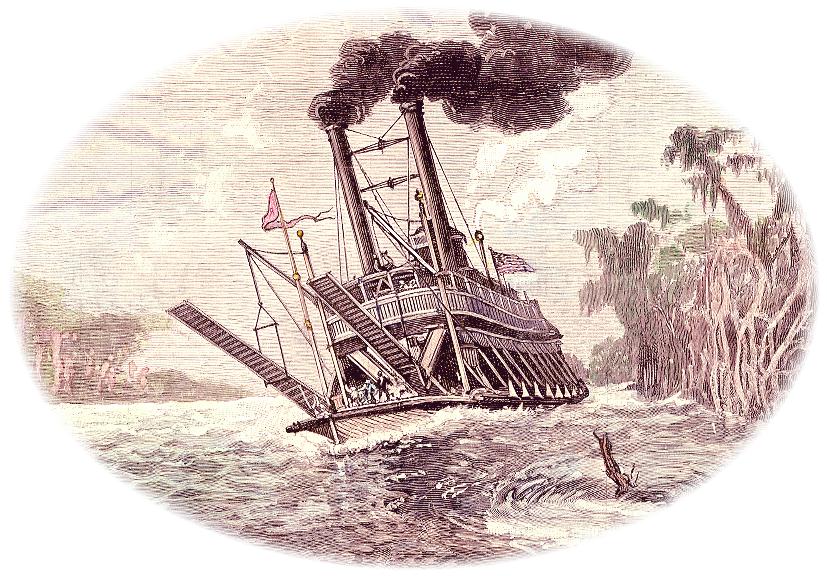
Harper's Weekly 14 April 1883 issue Steamboat resists a Whirlpool detail in oval vignette
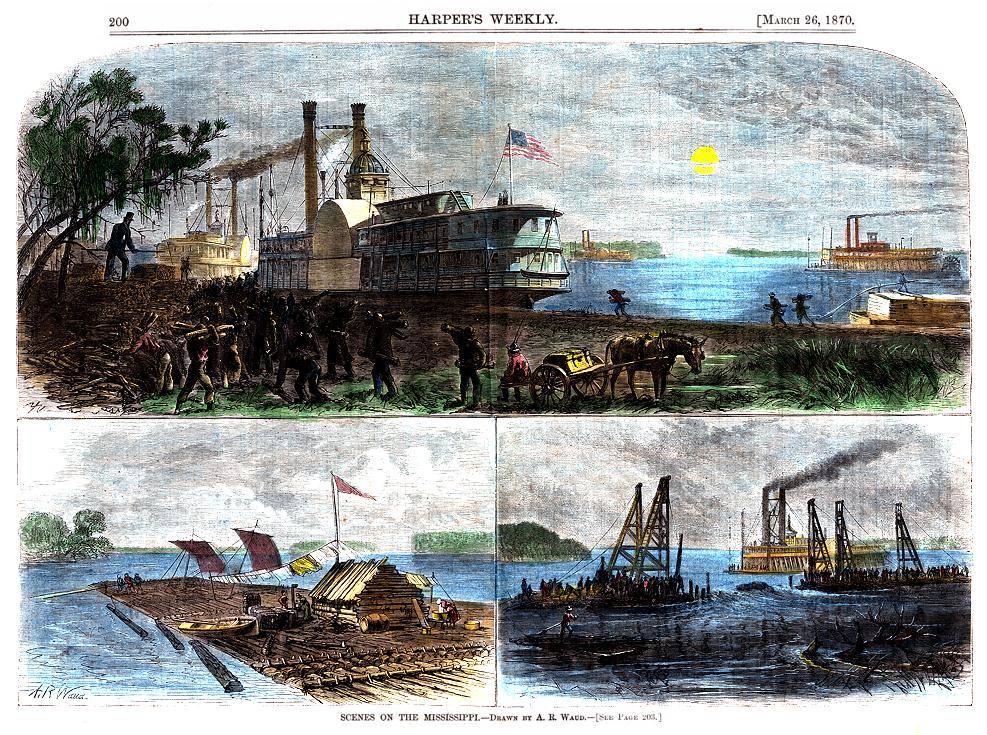
This is an original March 26, 1870 Harper's Weekly page (with color added by someone by hand) with 3 scenes that were drawn by A.R. Waud of scenes along the Mississippi River that were then prepared by engravers at Harper's for publication.
Alfred Rudolph Waud (1828-1891) was an artist and illustrator, born in London, England who emigrated to the U.S. where he became celebrated for the sketches he made on the battlefields and behind the lines during the entire length of the Civil War from 1861-1865. Waud's war time sketches were also engraved and illustrated news reports of the battles of the Civil War.
LADY LEE was built 1871, at Pittsburgh, Pennsylvania. Operated for the Carter Line from St. Louis to Red River, under Capt. G.F. Shields, master. In 1874 she was owned by the Illinois & St. Louis Packet Co.. She was lengthened from 176 ft to 227 ft in 1881. Ran for the Star Line in the St. Louis - Missouri River trade. On Mar. 29, 1882, she backed out of a landing 2 1/2 miles above Sibley, Missouri, into a strong side wind that drove her onto a snag, sinking her.
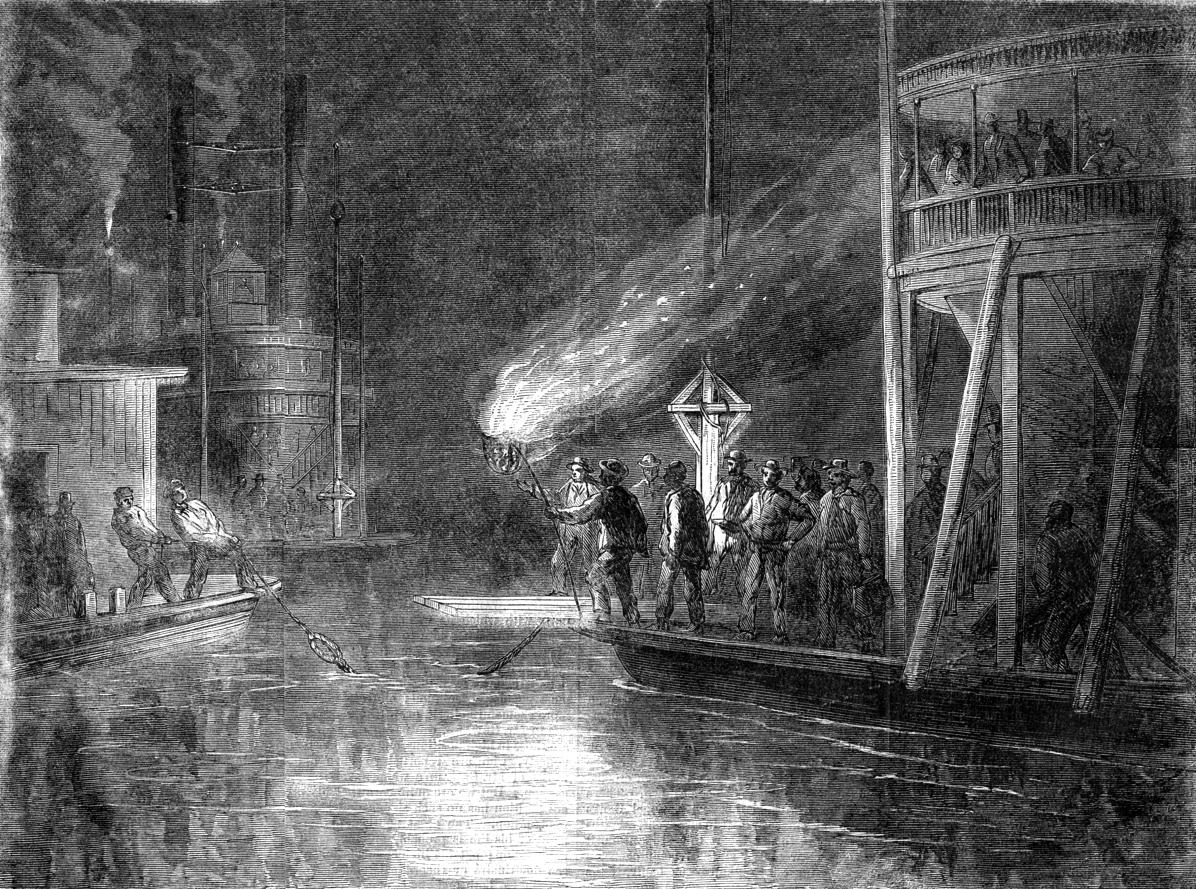
Steamboat Landing at Night for ENGRAVINGS Harper's 22 Dec, 1866
HARPER'S WEEKLY
December 22, 1866
Illustration front cover
"A MISSISSIPPI STEAMBOAT MAKING A LANDING AT NIGHT"
From a Sketch by Alfred R. WAUD
Wharfboat far left and another steamboat center while a steamboat with torch basket ablaze approaches from the right.
Text page 807 by Alfred R. Waud
All steamers plying on the Western waters carry a brazier, (known in river parlance as a "torch basket") in which, when making a landing, or loading and unloading freight at night, a brilliant flame is procured by filling it with dry pine chips. Flickering with a lurid glare, it produces most fantastic effects of light and shade, as the swarthy "hands" pass and repass, "wooding up," or stand grouped around the gang-plank. When the steamboat backs out again the brazier is reversed by a dexterous twirl on its axis, the blazing coast are dropped in swirling waters, and darkness reigns again.
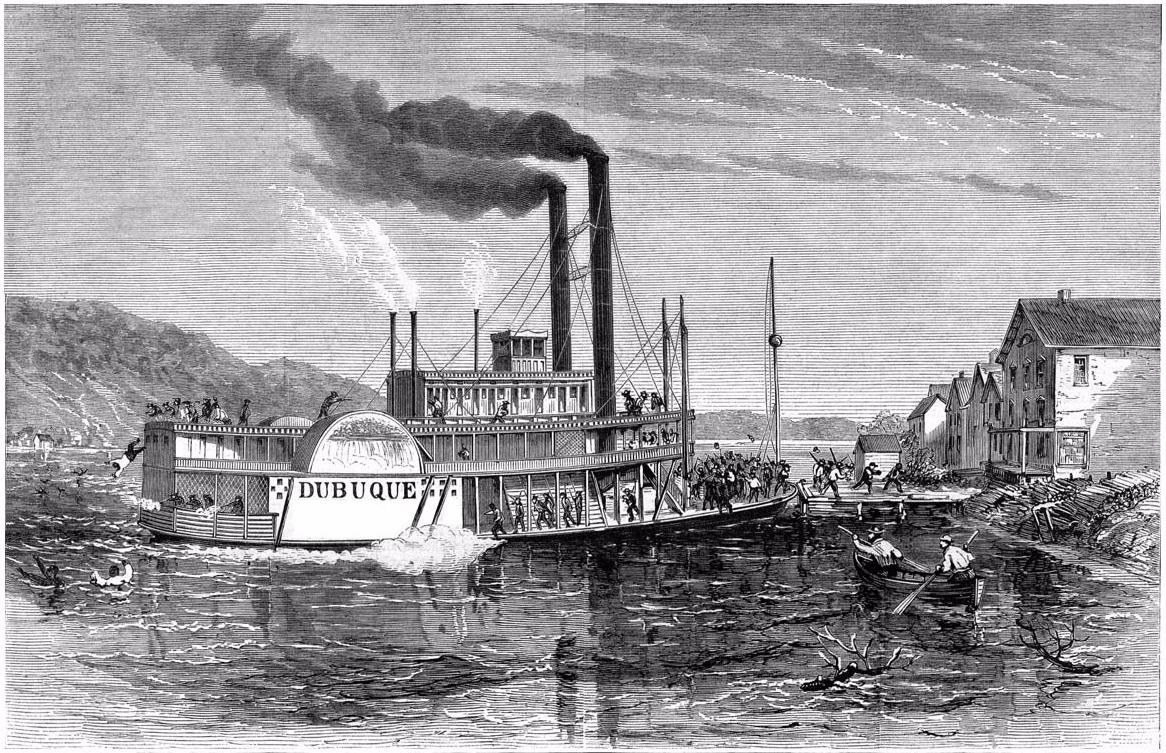
Harper's Riot aboard the DUBUQUE 1869
Was not able to make an acceptable reduction of this with the text on it but with image only and no margins it's at least better than what we have there now. (Harper's Engravings page)
Attached scan of page from Harper's Weekly 28 August 1869 illustrating a race riot (white raftsmen vs. black crew members) aboard the DUBUQUE (1867 -1879) on 29 July 1869 above Davenport, Iowa on the Mississippi. Below is additional information about the DUBUQUE riot from the Dubuque online Encyclopedia. encyclopediadubuque.org
The Dubuque, fully equipped and furnished at an estimated cost of $100,000, began service in 1867 as part of the Northern Line.
The boat was 230 feet long and operated with four boilers and two engines. Fifty-two "palace staterooms" were capable of accommodating 102 passengers. This boat's name, unfortunately, is linked to the worst race riot on the upper Mississippi.
On July 24, 1869, the Dubuque left Davenport with over two hundred deck passengers including many raftsmen who had been drinking heavily after being paid.
In an effort to prevent anyone from leaving the lower deck and not paying their fare, an African American clerk was posted on the stairs leading to the second deck.
A fight broke out when one of the lumbermen attempted to leave the lower deck for more liquor.
Sent back to the lower deck, the lumberman gathered his armed friends and began looking for every African American they could find.
The captain succeeded at Hampton, Illinois, in sending someone to shore for help.
The ringleader of the riot, Mike Lynch, slipped ashore at Comanche, Iowa. The boat was stopped by soldiers of the Rock Island Arsenal and the rioters were taken into custody.
Nine men were killed during the riot on the Dubuque.
The incident was the only one of its kind during seventy-five years of rafting on the upper Mississippi.
Ten of the rioters were later indicted.
Seven, including Lynch who was captured later, were sent to the state penitentiary at Joliet, Illinois.
In 1876 the ill-fated boat burned at Alton Slough while in winter quarters.
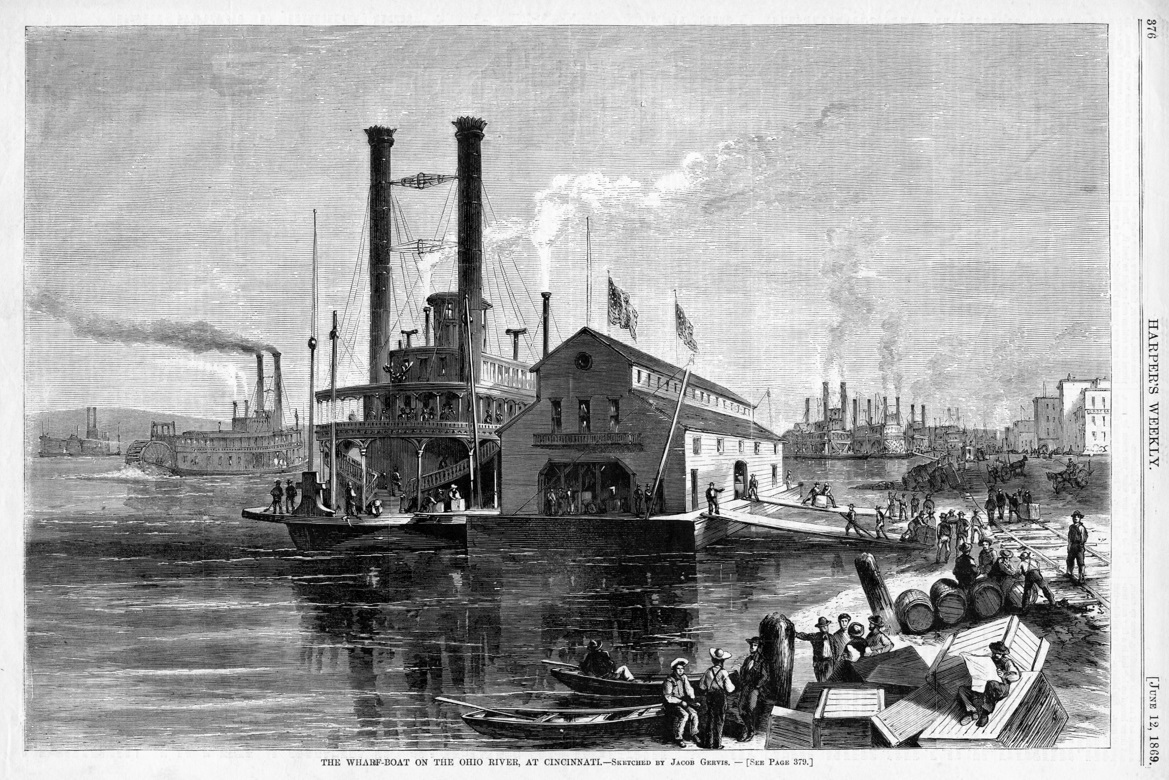
Interesting engraving based on a sketch by Jacob Gervis. Rather than being "box-shaped" the pilot house (on the steamboat tied up to the wharf boat) has a curved front in the style of a pilot house on an East Coast tug boat. It's hard to tell if the artist Gervis accurately captured the pilot house on that boat (which is not identified by name) or if the engraver changed the shape of the pilot house as a reflection of their familiarity with tug boats that plied the Hudson River and other waterways that emptied into the Atlantic Ocean.
Harper's Weekly
June 12, 1869
The short paragraph on page 379 that serves as a caption to the illustration on page 376
THE WHARF-BOAT
Our illustration on page 376 shows a peculiar institution on our Western Rivers, especially on the Ohio, where, owing to the rise and fall of the water, no stationary building upon the wharf would suffice for the purposes of steam-boat freight, and express offices, and where, therefore, a boat is made to answer such purposes. The boat is built two stories high, and is divided into compartments for business purposes. Our illustration gives a very complete idea of one these boats at Cincinnati, Ohio.
qctimes.com
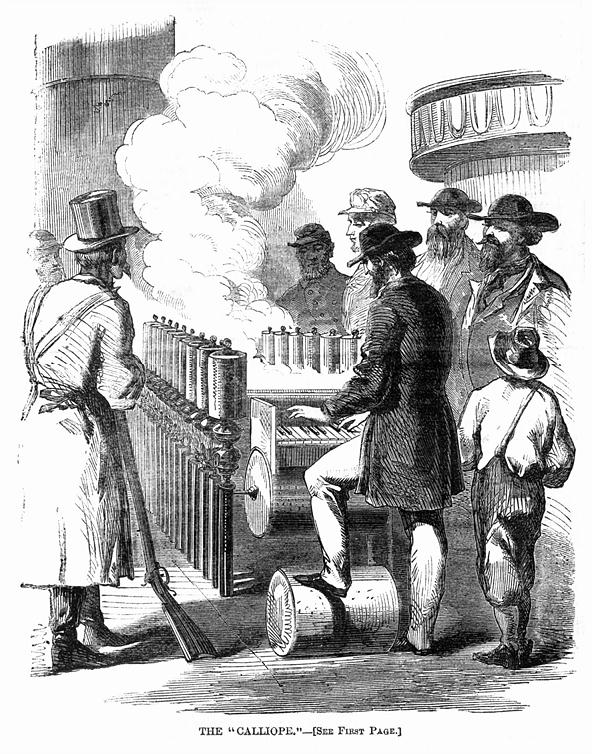
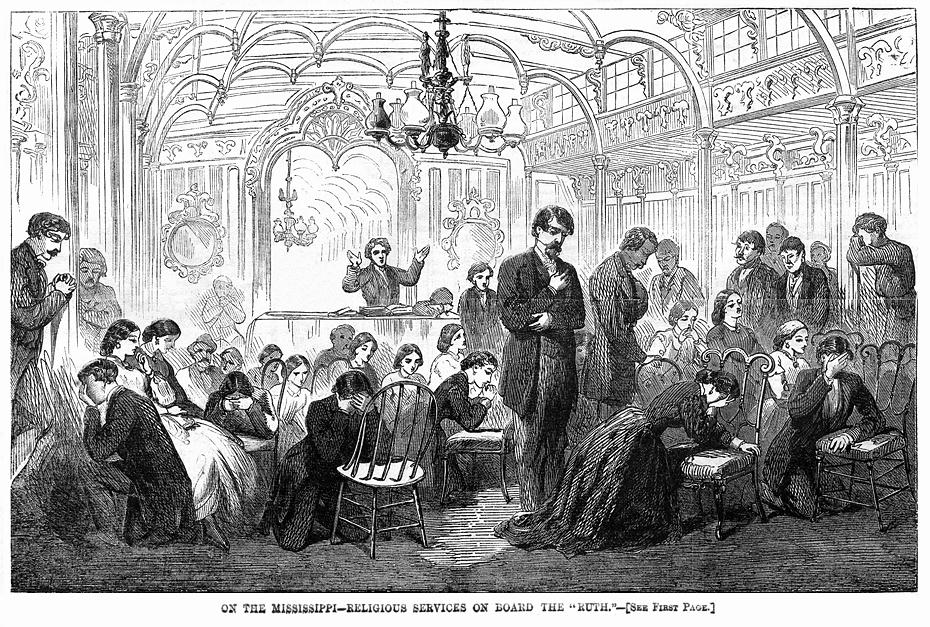
Got the full issue of the Harper's Weekly on 12 May, 1866 that contained engravings based on sketches of famous former war correspondent/artist A.R. Waud (Alfred Rudolph Waud) whose other steamboat art I've sent recently.
Waud wrote the text and refers to his drawings along with comments on an early cally-ope on an un-named steamboat and a church service aboard the steamer RUTH which Waud had traveled down the Mississippi on board from Cairo, Illinois.
The text is on page one and the 2 illustrations both on page
Waud captured the arches overhead and the elaborate mirror reflecting the cabin behind the preacher in the RUTH's cabin very nicely. They're complexity required an experienced draughtsman. The engraver had probably never been in the interior of this style of steamer so the skylights overhead are more conventionally proportioned rectangles, not as long and narrow as most of those overhead windows were.
HARPER'S WEEKLY
NEW YORK, SATURDAY. MAY 12, 1866.
LEVEE AT CINCINNATI.
The good people of Cincinnati look upon their city as some pumpkins' in a business point of view, and point to their levee as an illustration.
I should imagine that the levee does nearly as much business as six New York piers.
At about starting time' there is a great confusion of bells, whistles, and Calliopes.
THE CALLIOPE.
Attracted by one of the latter, I went aboard to see how the thing was done.
The reader will see how from the sketch I have made.
Certainly it was the best iron-clad music I had heard; and, strange to say, the whistles were in tolerable tune.
RELIGIOUS SERVICE ON THE RUTH.
The Ruth, one of the finest riverboats, went down the Mississippi from Cairo with your artist, a full complement of passengers, and, it was said, 2600 tons of freight.
As among this transient population there were twelve ministers on their way to the General Conference of the Southern Methodist Episcopal Church in New Orleans we had service on the Sabbath in the gorgeous cabin of the steamer.
The President was prayed for, but Congress was ignored.
The amens to the name of JOHNSON were many and emphatic.
The congregation was attentive, among the most devout being some gamblers.
At the close of the service a subscription was proposed for the benefit of the Methodist Church in Fredericksburg, Virginia, destroyed by the war.
To this I noticed that two Jews contributed, anxious, I suppose, to stand well with their Southern brethren of the Gentile persuasion.
As for the ministers they exhibited feelings of bitterness toward the North quite unworthy of their profession.
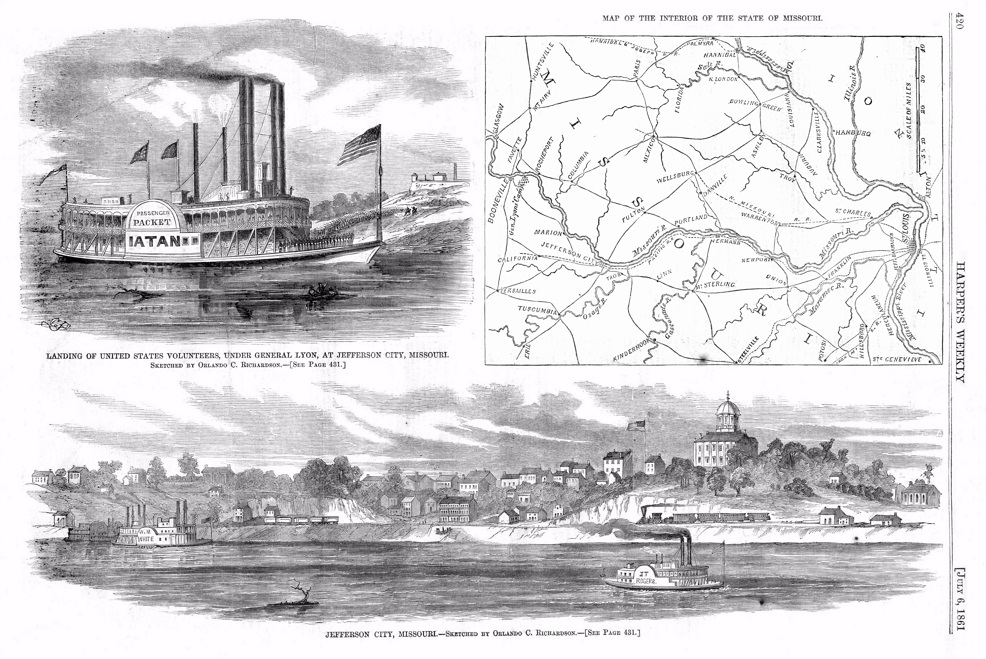
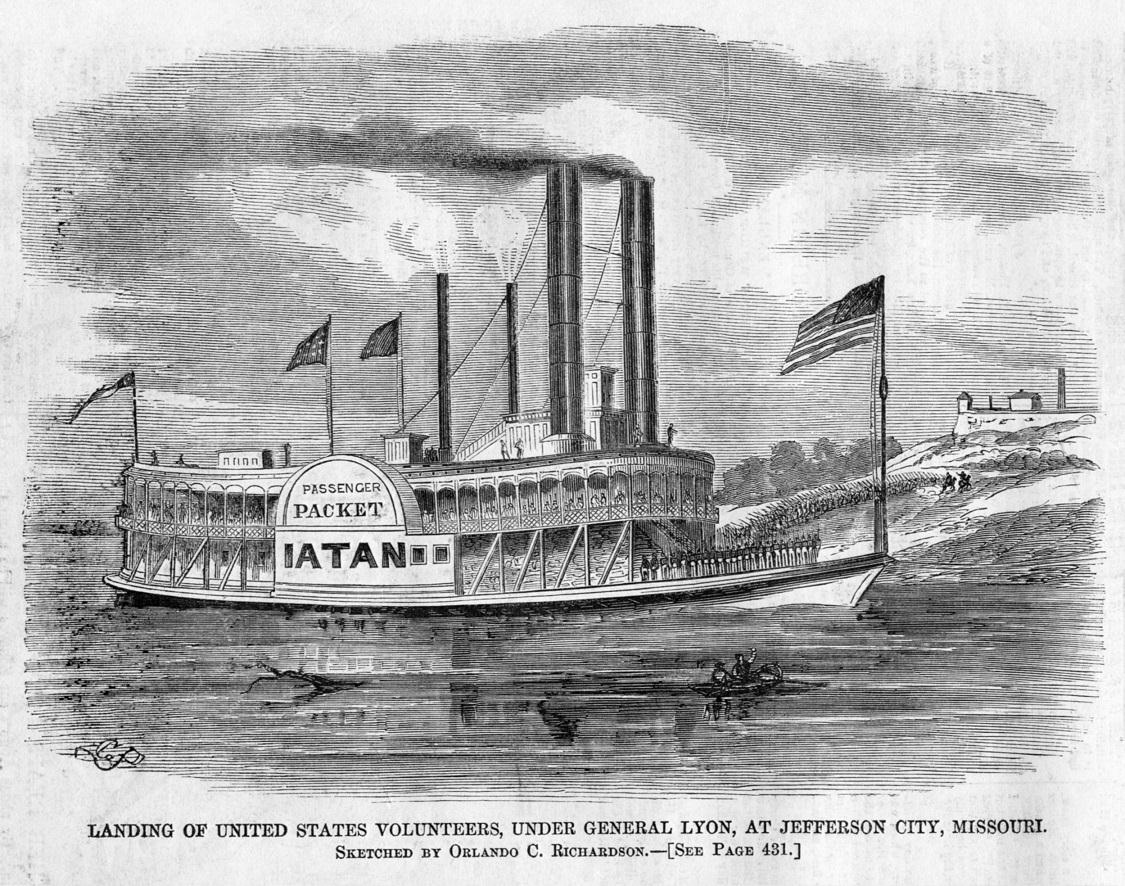
From 6, July, 2015 Harper's Weekly page 420
I have attached an enlarged detail of the upper left hand corner with the engraving of the steamer IATAN and a reduced file of the whole page which includes a map of a portion of Missouri and a panorama of Jefferson City on the Missouri River.
Included below is a transcript of the article on page 431 describing THE (CIVIL) WAR IN MISSOURI, which relates to the illustrations on page 420.
IATAN
Sidewheel Packet
Way's Packet Directory Number 2699;
Built in Cincinnati, Ohio in 1858 for Captain H. S. Eaton and others for the Missouri River trade.
Served as a troop transport boat during the Civil War and carried U.S. volunteers to Jefferson City, MO, in 1861, illustrated here in a sketch by Orlando C. Richardson in Harper's Weekly 6 July, 1861
Ran Mobile-New Orleans, 1865.
Was in the cattle trade out of Shreveport, Louisiana in 1868; Captain John Hein, owner and master.
Dismantled 1868.
sonofthesouth.net
THE WAR IN MISSOURI. page 431
On page 420 we illustrate the outbreak of the war in Missouri. We give a view of JEFFERSON CITY, MISSOURI, and the LANDING OF UNITED STATES VOLUNTEERS there, from sketches by Mr. O. C. Richardson, of St. Louis ; and on the same page an instructive Map of the Seat of War in Missouri. In our last number we mentioned the departure of Governor Jackson from St. Louis, his traitorous proclamation, and the departure of General Lyon in pursuit of him on the steamer IATAN. A correspondent thus describes the landing at Jefferson City :
On the morning of the 15th, ten miles below Jefferson City, General Lyon transferred his regulars to the IATAN, and proceeded with that boat, leaving the SWAN to follow in his wake. As we approached the city crowds gathered on the levee and saluted us with prolonged and oft-repeated cheering. Colonel Thomas L. Price (no relative to the rebel, Sterling Price), a prominent Unionist of Jefferson City, was the first to greet General Lyon as he stepped on shore. A bar has formed at the regular landing, and we were obliged to run out our gang plank below the penitentiary, at a point where the railroad company has placed a large quantity of loose stone, preparatory to forming a landing of its own. The steep, rough bank prevented the debarkation of our artillery, but the infantry scrambled up in fine style. First was the company of regulars formerly commanded by General Lyon, but now led by Lieutenant Hare. These were sent to occupy a high hill or bluff near the railroad depot and commanding the town. They went forward in fine style, ascending the steep acclivity at the "double-quick step." In one minute from the time of reaching the summit they were formed in a hollow square, ready to repel all attacks from foes, whether real or imaginary. Next came the left wing of the First Volunteer regiment, under Lieutenant-Colonel Andrews, five hundred strong. These soldiers were formed by sections and marched to the tune of "Yankee Doodle," with the Stars and stripes conspicuous, through the principal streets to the State House, of which they took possession amidst the cheers of the people of the town.
After some delay in finding the keys, which had not been very carefully hid, Lieutenant-Colonel Andrews with a band, color bearer, and guard, ascended to the cupola and displayed the American flag, while the band played the "Star Spangled Banner," and the populace and troops below gave round after round of enthusiastic applause. Thus was the "sacred soil" of Missouri's capital invaded by Federal troops, and the bosom of "the pride of the Big Muddy" desecrated by the footprints of the volunteer soldiers of St. Louis. She rather seemed to like it.
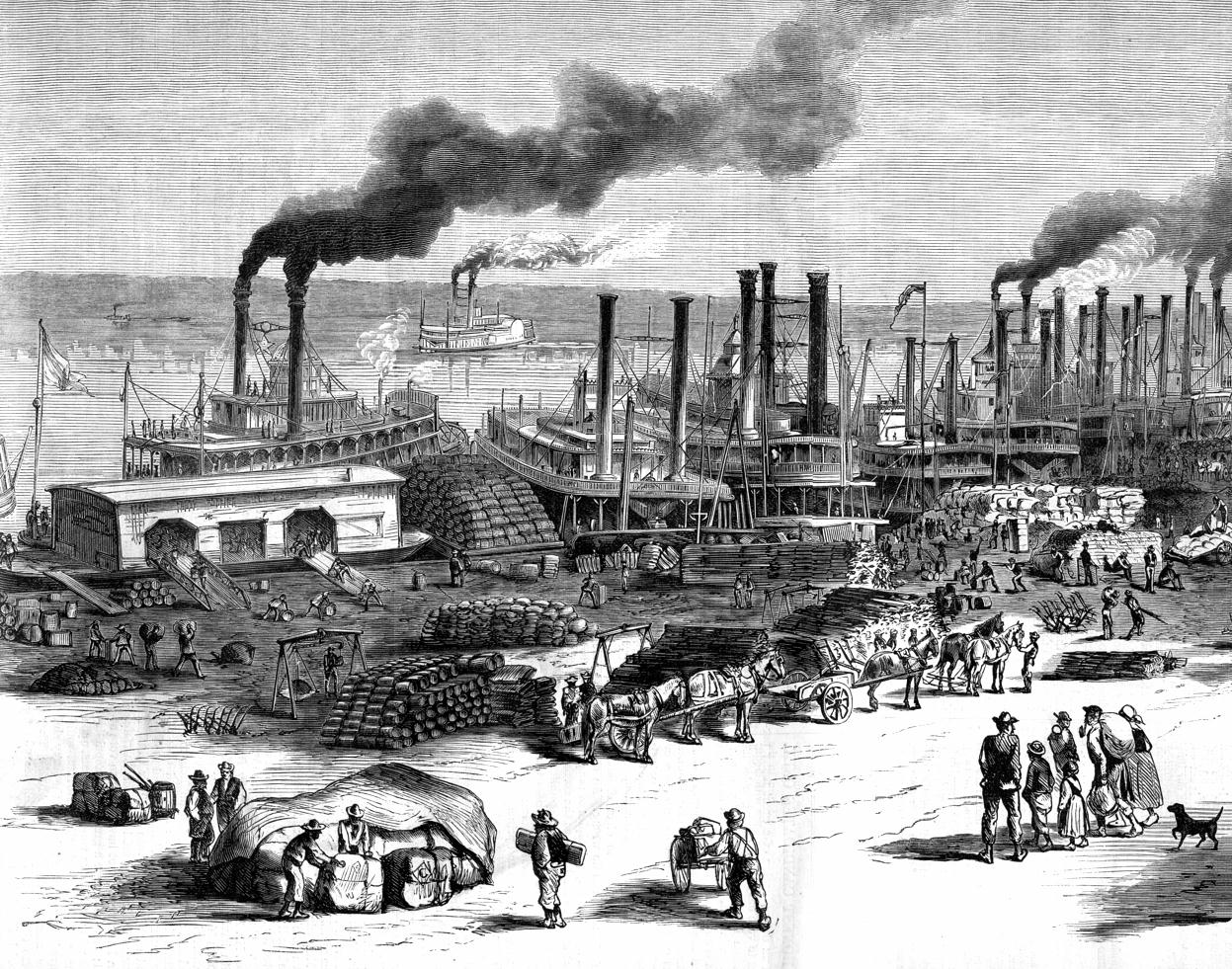
Harper's Weekly 14 October 1871 St. LOUIS LEVEE for Engravings
HARPER'S WEEKLY October 14, 1871
Detail of an engraving on page 956 from a photograph by R. Benecke
Our illustration on page 956 represents the St. Louis, Missouri levee, where the steamboats plying up and down the Mississippi River make their landings. It extends for miles along the riverbank and as our illustration shows, presents a very lively appearance. The Western steamboats are better subjects for the artist's pencil than those to which we are accustomed, being more picturesque in form, and the characters and costumes of crew and passengers being often outlandish and curious.
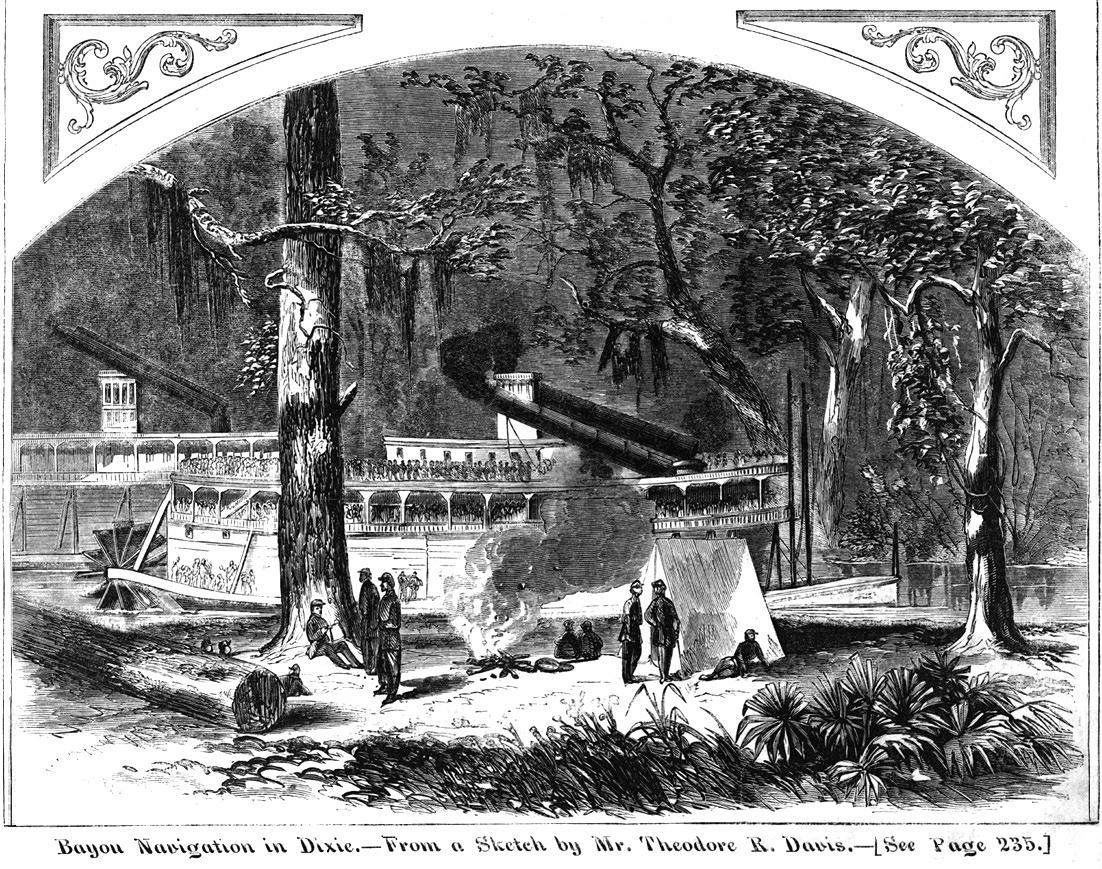
Engraving from cover of Harper's Weekly April 11, 1863
"Bayou Navigation in Dixie - From a sketch by Mr. Theodore R. Davis"
[Smoke stacks are tilted back to allow the steamboat to clear low hanging overhead branches in the Bayou]
Difficulties of working among the bayous Bayou navigation in Dixie from a sketch by Mr. Theodore R. Davis Bottom engraving from the cover "page 225" of Harper's Weekly, vol 7, no. 328 (April 11, 1863)
The accompanying text on page 235:
IN THE BAYOUS.
OUR special artist, Mr. Theodore R. Davis, has sent us sketches of the work of CUTTING THROUGH THE SOUTHWESTERN BAYOUS, which we reproduce on page 225. With the sketches we received the following correspondence, which is interesting:
"ARMY OF THE TENNESSEE, NEAR YOUNG'S POINT, LA., Tuesday Night, March 17, 1863.
The present stage of water in the Mississippi has, as you are aware, partially overflowed the Louisiana peninsula opposite Vicksburg; has encroached upon the encampments of our troops, compelling one of the corps of the army to remove to Milliken's Bend; and has even trespassed upon the sacred precincts of the dead. One of the many rude burial-places down here, where the defenders of the republic who fell in battle last December, and who have since perished of disease, are now lying in eternal silence, but with glorious suggestiveness, has been inundated by the flood, and the graves are but partially visible above the surface of the broad-expanding waters.
Melancholy, touchingly sad, looks the roughhewn cemetery when the sky is clouded and the moon beams out, ever and anon, as if in pity, upon the buried heroes whom Fortune has not spared and the elements will not respect. It would seem, to a poetic mind, as if the pale priestess of heaven were offering up a prayer in her nightly vigils for the gallant dead, whom a grateful nation's memory should embalm, as they lie in their narrow tombs so far away from their native homes, with no requiem save that the mournful Mississippi chants, and no audible lament but that the soft Southern breezes waft over this dull and dreary shore."
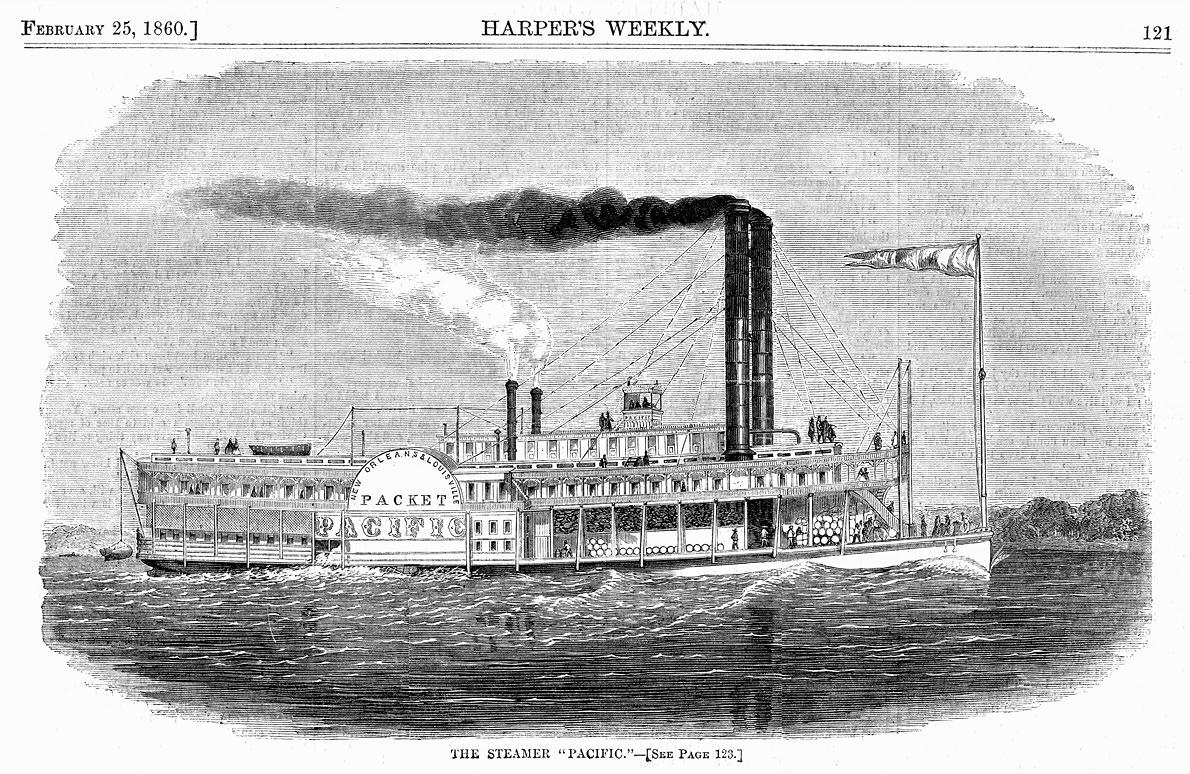
PACIFIC Sidewheel packet Way's Packet Directory Number 4373
Built at New Albany, Indiana 1857
603 tons. 290 x 40 x 8. Engines, 28's- 9 ft. Six boilers, each 40" by 28 ft .
Owned by J. Bragdon & Co., Louisville.
Ran Louisville-New Orleans, Capt. William Lamb.
Other masters were Captains Anson McGill and Jesse K. Bell.
Clerks included W.Y. Halliday and R.A. Barclay.
She was coaling at Uniontown, Kentucky November 18,1860, when she burned with loss of eight lives 268 days after Harper's Weekly published this engraving of the PACIFIC on February 25, 1860.
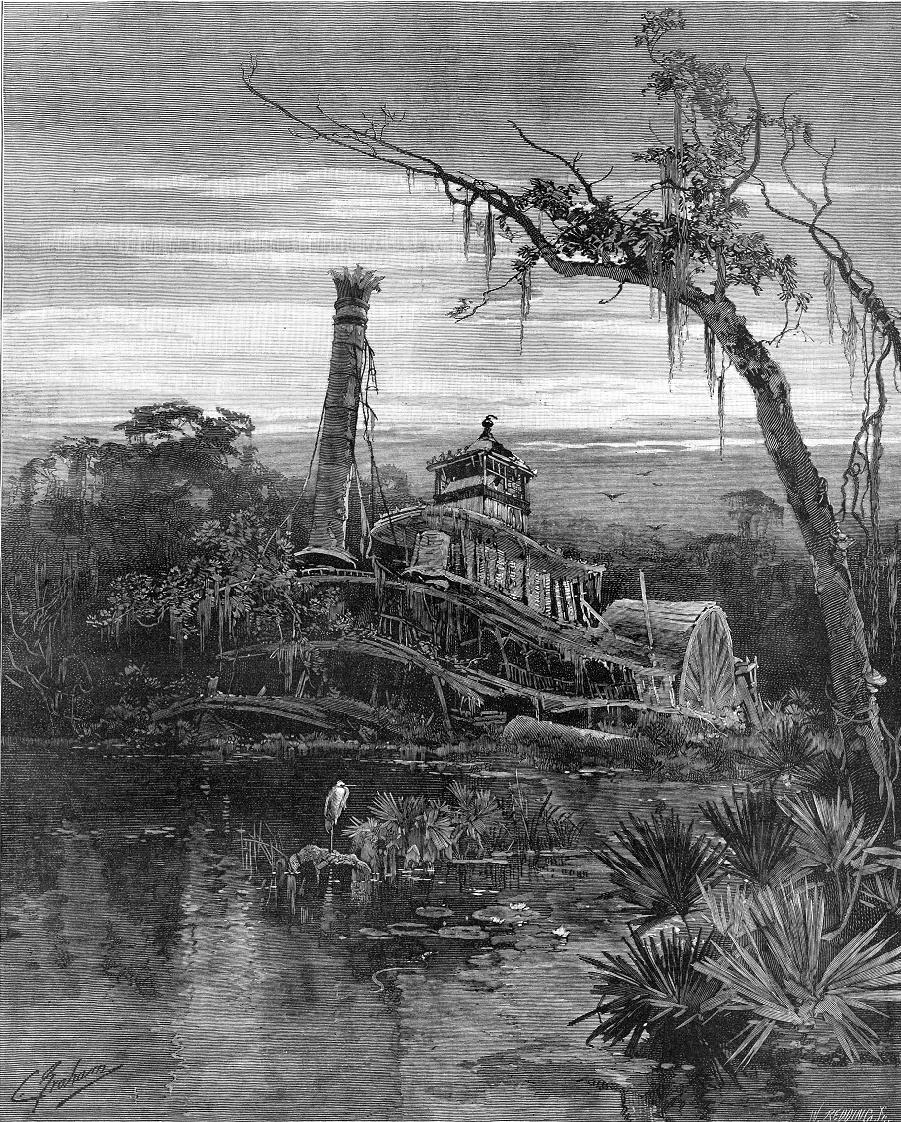
I received a complete edition of this 1888 Harper's Weekly which I've been meaning to track down for its cover for a long time.
Attached scan of the cover art without the "banner" above or the caption below.
The caption mentioned a POEM on page 694 which I have transcribed below. It's rather typical of its time or even a much earlier time, archaic in style but interesting nonetheless.
Better not reduce this any smaller than this if you post it or the "moray" pattern will become very distracting.
The original artwork was credited to Charles Graham (hard to tell if the original was a painting or a drawing).
The engraving was made by W. Redding Jr.
This image has been copied by other artists who especially like the heron or egret that is standing on one leg in the foreground below the derelict steamboat.
HARPER'S WEEKLY
15 SEPT 1888
page 694
THE U. S. M. MISSISSIPPI PASSENGER STEAMER.
1855-61.
Where the black bayou pools,
In the flags and cypress stools,
It drops a dusky halo
In the opalescent shallow
That crowns in somber dimness.
A steamer's bulk and chimneys;
As if the crevasse had caught her,
Docked in her coffin, and hurried her,
In the arms of the pitiful water,
Into her grave and buried her.
The pastel painting mold
In colors of slime and ooze
Has laid their delicate hues
In panels of greenish gold;
And the vines in the grand saloon
Have woven a silk cocoon,
Like beds of the butterfly-moth;
But the gray moss has over all
Drawn a funereal pall
Of satiny velvet cloth.
How changed since the flying swallow-tail
At her flag-staff was symbolical
Of the Pride of the River, chiding
The fat salt marsh of the bayou,
When the lords of the South came a-riding
From the Gulf to the Falls of Ohio
On business lively as pleasure;
And the wealth of her gilded cabin
Was rich with a richer treasure
Than the Roman stole from the Sabine!
What has become of her Master?
What has become of her men?
Her damasks and lambrequin,
Ormolu and alabaster?
Her nostrils breathing benzene,
When throes of her mighty engine
Made chandeliers clink and shiver
To the throttle's hollow diphthong;
And the coils of tire sinuous river
Unwind like a flying whip-thong,
As she blows a smoky streamer
(That pictured photographic
The bends of the river traffic)
In the nose of her rival steamer?
What if some night-worn pilot,
By new cut or low sand islet,
Hears the capstan song of her dead men;
The pant of her engine churning,
The part of her buckets turning,
And the long soft cry of her lead-men,
As he sees her head-light burning
In the bends of the old dead river,
As of old the bold Sir Berliner
Saw the white barge of the king come,
And he swears a prayer or two;
Not for the National Income,
Less than the Evangelists
Would care or dare e'er to
Look on her passenger lists;
Or the marvelously splendid
Cargoes she has to deliver
On the banks of the old dead river ;
For the days of her glory are ended;
Captain and capstan-song,
And the phantoms she chased so long.
Ended her noble winnings,
That once set the river a-talking;
The junk-shop has scored her innings,
And the fungus is doing her calking.
But the tall magnolias above her
Hang like a mourning lover,
Dropping their immortelles
In the long, unbroken swells
That picture in polished emery
Cut-water to cabin spar,
Clear as a widowed memory
Of the days before the war.
- WILL WALLACE HARNEY.
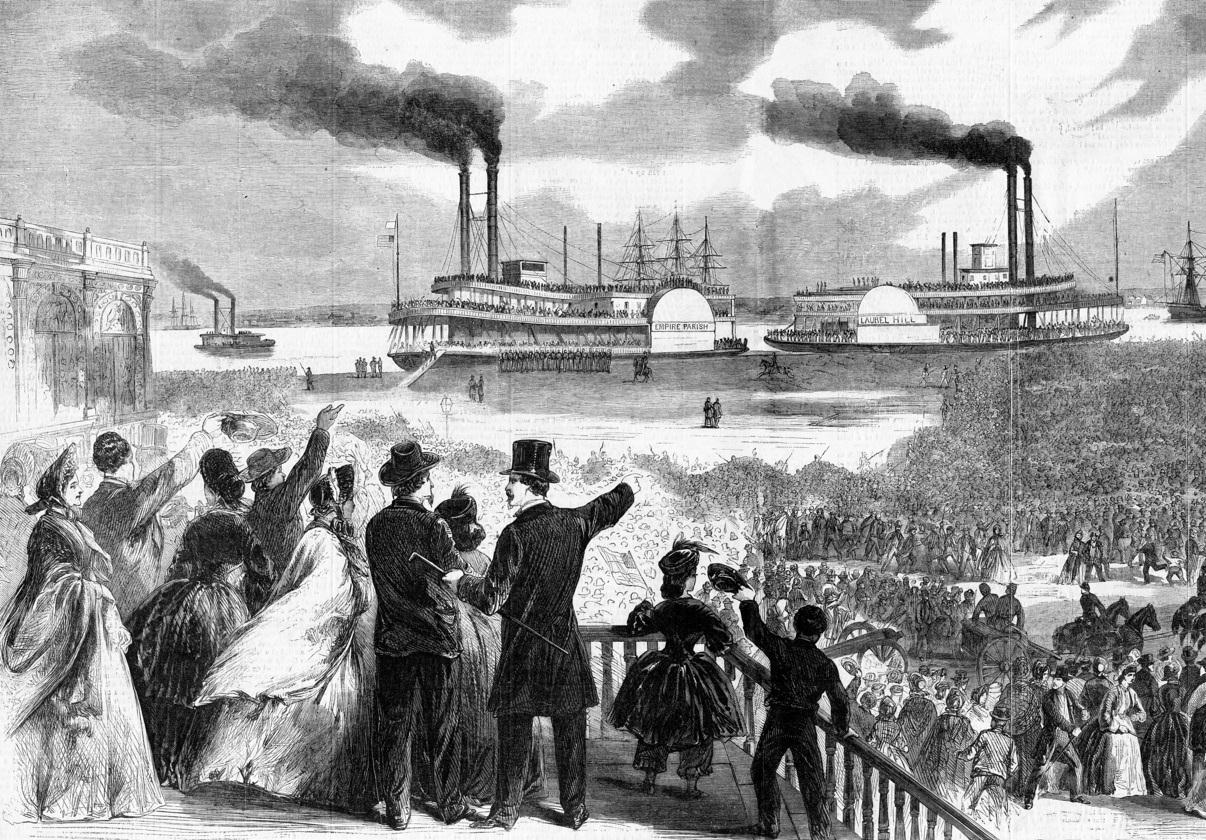
Harper's Weekly 1863 Steamboats EMPIRE PARISH and LAUREL HILL
Steamboats EMPIRE PARISH and LAUREL HILL Harper's Weekly
21 March 1863 pages 184-5
"SCENE ON THE LEVEE AT NEW ORLEANS ON THE DEPARTURE OF THE PAROLED REBEL PRISONERS FEBRUARY 20, 1863"
Sketched by Mr. Hamilton
page 186
Transcript of the ARTICLE:
EXTRAORDINARY EXCITEMENT IN NEW ORLEANS.
A very extraordinary exhibition of public feeling took place in New Orleans on Friday the 20th of February, which threw the whole city in the wildest excitement; but was, fortunately, attended with no serious consequences. We illustrate the scene on pages 184 and 185.
It having been publicly announced that a flag-of-truce boat would leave on Friday to convey some 382 paroled prisoners to Baton Rouge, and there exchange them on board a rebel vessel for Port Hudson, an immense concourse of the disloyal portion of the community congregated on the levee to see them go off. The EMPIRE PARISH, with the prisoners on board, was lying at the foot of Canal Street, and the LAUREL HILL—moored immediately ahead of her—was selected by about 1000 at least, who crowded into and upon every part of her, to see the rebel prisoners and cheer them.
The EMPIRE PARISH had been advertised to leave at three o'clock, and it must have been as early as noon that the masses commenced to assemble. By two o'clock the whole levee, in its enormous width and extending all the way from Canal to Julia Street, was one dense sea of human heads; a large proportion of them females wearing secesh badges, and many openly waving little rebel flags—an insult not confined to their sex alone.
Seeing that matters were assuming a disgraceful if not alarming aspect, notice was sent to General Bowen, advising him of the fact, and suggesting the necessity of sending down some troops. The order was at once given, and soon a squad of the Twenty-sixth Massachusetts were on the ground, and a portion of a battery came threading its way through the crowd.
The scene at this moment was grand and exciting. The immense crowds on the levee swaying back by the advance of the soldiery—the LAUREL HILL and the EMPIRE PARISH both one living mass of human beings cheering vociferously—and the balconies and windows facing the river teeming in every available spot, even to the roofs—the females screaming and waving their handkerchiefs, scarfs, flags, and parasols.
The order being given, the soldiers began to make the crowd move back; a delicate task not easy to effect, as the women were all in front, thus screening the men behind an impassable and invincible barrier of crinoline. The soldiers, however, behaved with perfect order, temper, and decency, making no reply to the insulting taunts from hundreds of the weaker sex, but, holding their muskets horizontally, gently made the crowd fall back. The balconies were also cleared of all their demonstrative occupants, and thus at last the whole mass was grumblingly dispersed, and the EMPIRE PARISH had to crawl off quietly in the night without that grand parting scene which the rebels evidently expected, and which the scene in the morning clearly promised. Upon the whole, it was a disgraceful and dangerous exhibition, and one which certainly ought to have been, and could have been, prevented had any ordinary means been used for avoiding its occurrence.
"Steamboats on Louisiana's Bayous A HISTORY AND DIRECTORY"
Copyright CARL A. BRASSEAUX and KEITH P. FONTENOT
LOUISIANA STATE UNIVERSITY PRESS - BATON ROUGE
EMPIRE PARISH was a sidewheeler built at new Albany, Indiana, in 1859. Dimensions: 170 x 32 x 6 feet. In 1859, the EMPIRE PARISH, commanded by Captain R. Baldwin, ran as a packet with connections to the Lower Coast (the parishes along the Mississippi between New Orleans and Baton Rouge) and the Quarantine Station below the Crescent City. The EMPIRE PARISH operated as a packet running between Donaldsonville and New Orleans, April 59, 1860 - December 4, 1862. Captain Vincent commanded the steamboat from April 1860 through mid-April 1861. He was succeeded by Captain Grant around April 20, 1861. Grant was replaced by Captain Bayhi around April 11 1862. Captain Elfert assumed command of the vessel around November 19,1862. The New Orleans and Plaquemine Steamboat Association operated the vessel in 1861. William J. Reid of New Orleans acquired the EMPIRE PARISH in 1862. The vessel was destroyed when fire consumed nine steamers along a wharf on May 28, 1864.
Sources: New Orleans Bee, April 19, 1860 — December 4, 1862 Way's Packet Directory, 151-52.
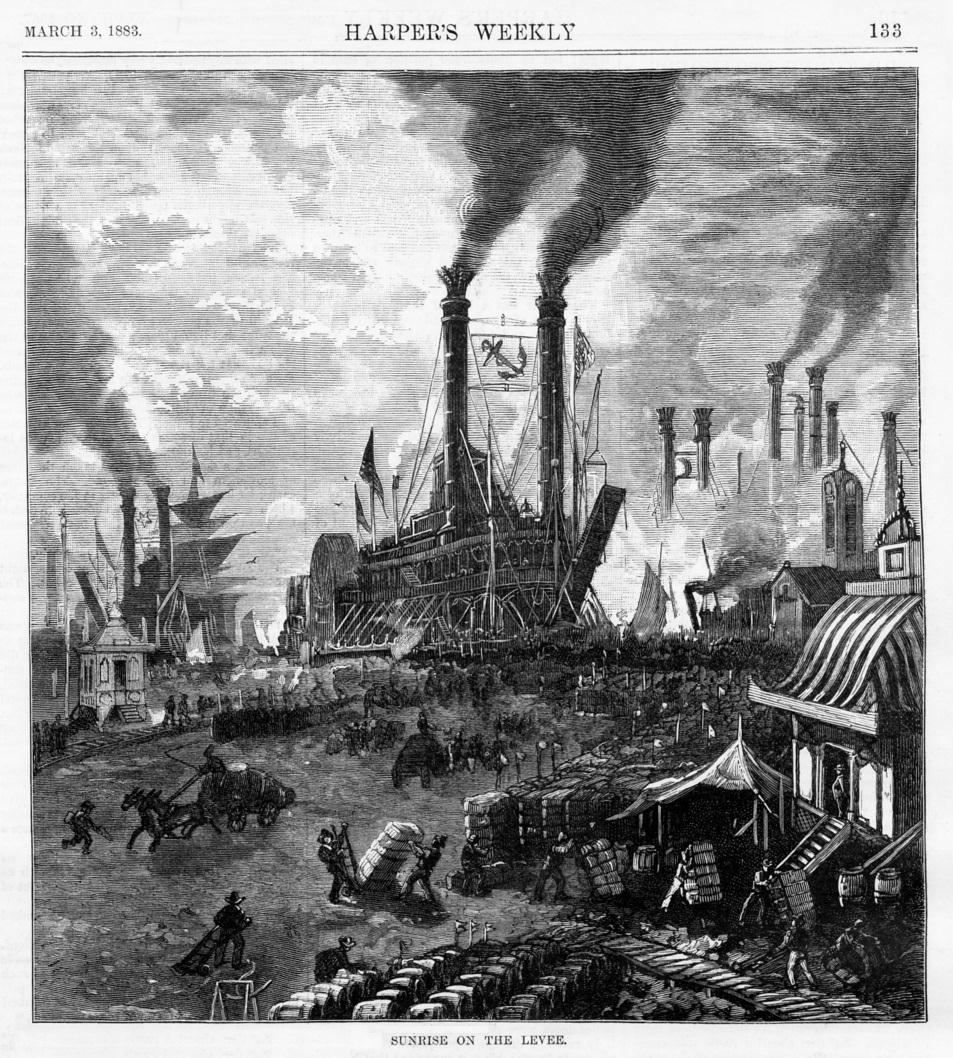
Harper's Weekly Engraving 3 March 1883 page 133 Dramatic Silhouette of Steamer at New Orleans
One of Harper's most dramatic engravings of a what appears to be a huge boat silhouetted moored on the New Orleans levee.
HARPER'S WEEKLY
MARCH 3, 1883.
PAGE 133
NEW ORLEANS LEVEES.
The broad levees which protect the city of New Orleans against the assaults of the Mississippi are crowded day and night by picturesque and motley throngs of people, representing every phase of seafaring and river life. The scene is bewildering to a stranger and our artist, who has endeavored to convey a pictorial idea of it, confesses that he was at a loss to know what to choose from the amazing variety of incidents and characters that passed in a continually changing panorama before his eyes.
Even by night the levees present scenes of bustling activity. New Orleans is far ahead of most Northern cities in the use of the electric light. Even dingy back streets and narrow alleys are illuminated by its powerful rays, and it is not uncommon to find the brilliantly lighted globe of glass swinging in front of some picturesque tumble-down shop, which doesn't look as if its whole stock would be valued at more than a hundred dollars or two.
As many portions of the city, especially the older streets, are wonderfully picturesque and quaint, the electric illumination produces effects which are nowhere else observable.
Along the levees the electric lights are suspended in rows from high poles, affording a broadly diffused light, by means of which the business of loading and unloading the ships, steamboats, and other craft is carried on with as much facility as by day some of the globes are variously colored, to designate different localities. Our artist made his sketch on a clear night, in order to show the busy scene to the best advantage, and convey an idea of the extent and variety of the work carried on after sunset along the river-front; but there are nights when the heavy sea fog comes sweeping up, like a gray wall, obscuring all the shipping and enveloping the levees. The effect is then wonderful. Everything wears an uncertain, weird, and ghostly appearance. Gustave Doré would have reveled in these scenes, where he would have found subjects for his pencil as marvelously quaint and picturesque as in any of the older portions of Paris or London.
What her great dikes are to Holland the levee is to New Orleans. Without this enormous embankment, fifteen feet wide at the top and extending for two hundred miles above and fifty below the city, her streets would be subject to inundation every spring.
The author of " Hudibras" described Holland in humorous verse as "a country that draws fifty feet of water," where people "do not live, but go on board." The description might have applied in some degree to the New Orleans of earlier times ; but engineering skill and a judicious outlay of money, applied to the construction of the levee, and an extensive system of drainage, have made it one of the most healthful and pleasant cities of America.
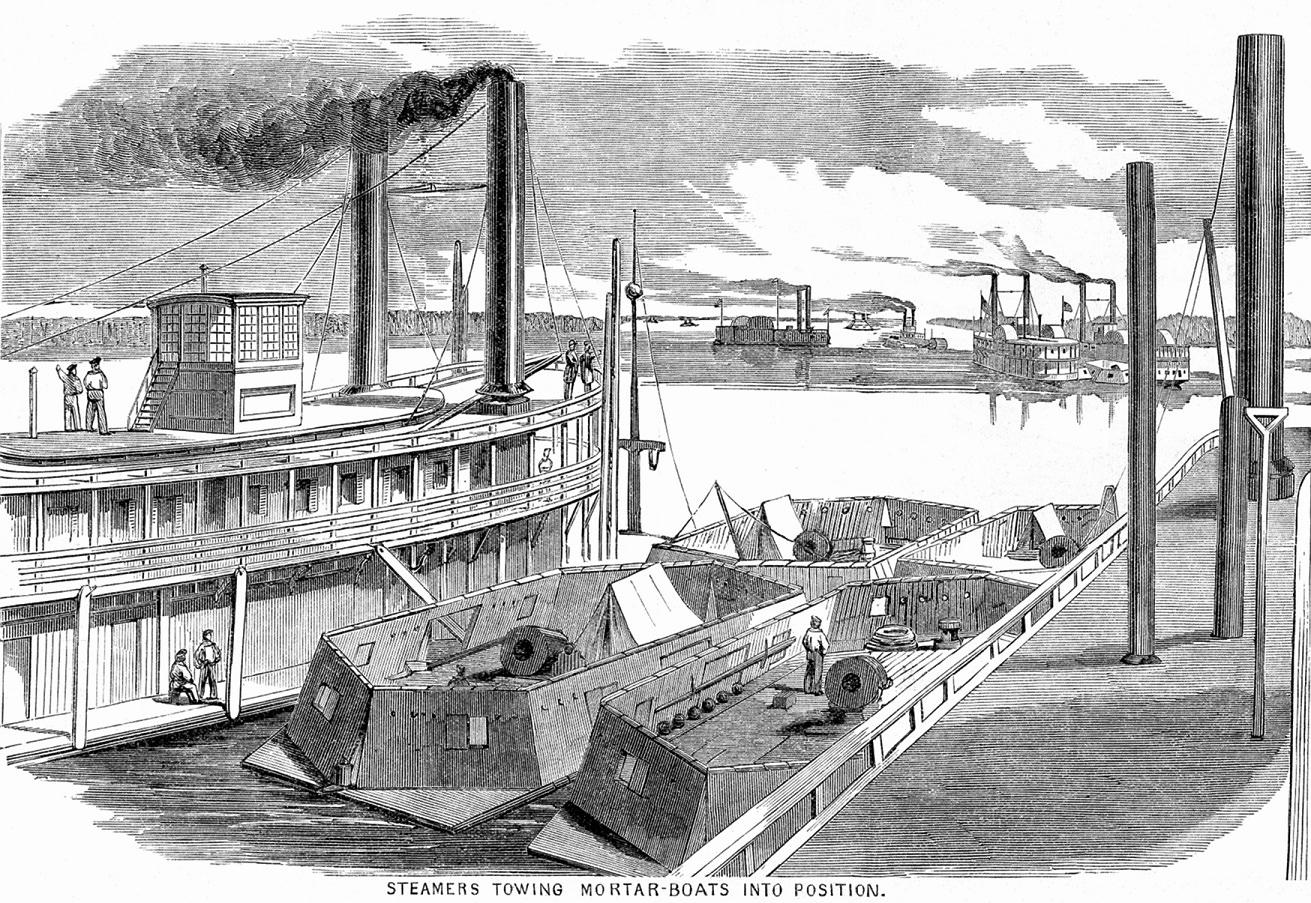
HARPER'S WEEKLY April 5, 1862
Civil War maritime bombardment of Island No. 10
Best of three engravings on page 212 made from sketches by Alexander Simplot illustrating the preparation by the U.S. Navy for the Bombardment of Island Number Ten by the mortar fleet, March 16, 1862.
"Steamers towing mortar-boats into position."
from "Harper's History of the Great Rebellion" Page 294 received here on 18 July, 2016
Caption derived in part from Philadelphia Print Shop: philaprintshop.com
"Capture of Island No. 10" March and April 1862
U.S. General John Pope, after taking New Madrid, was determined to take Island 10, the only Confederate stronghold left on that part of the Mississippi River.
However, Pope's army was on the western side of the river and he needed protection for his troop transports so he could cross to the eastern side in order to be able to attack Island 10.
Commodore Andrew Foote, meanwhile, had his fleet of ironclads and mortar rafts moored on the upstream side of the island, from whence he continued to lob shells at the Confederate stronghold.
Foote was reluctant to try to run his ships by the heavily gunned Confederate position in order to provide his troops with the protection they needed.
Finally, Commander Henry Walke volunteered to run the gauntlet at night in his ship the U.S.S. CARONDOLET, which he did on April 4th; a second iron clad followed two night later and Pope had his protection to ferry his troops to the opposite shore. Almost immediately, the Confederates on Island 10 surrendered, leading to the capture of thousands of soldiers and much ordnance and ammunition. This gave the Union control of the Mississippi as far south as Memphis. This Federal victory also made John Pope a new hero in the North.
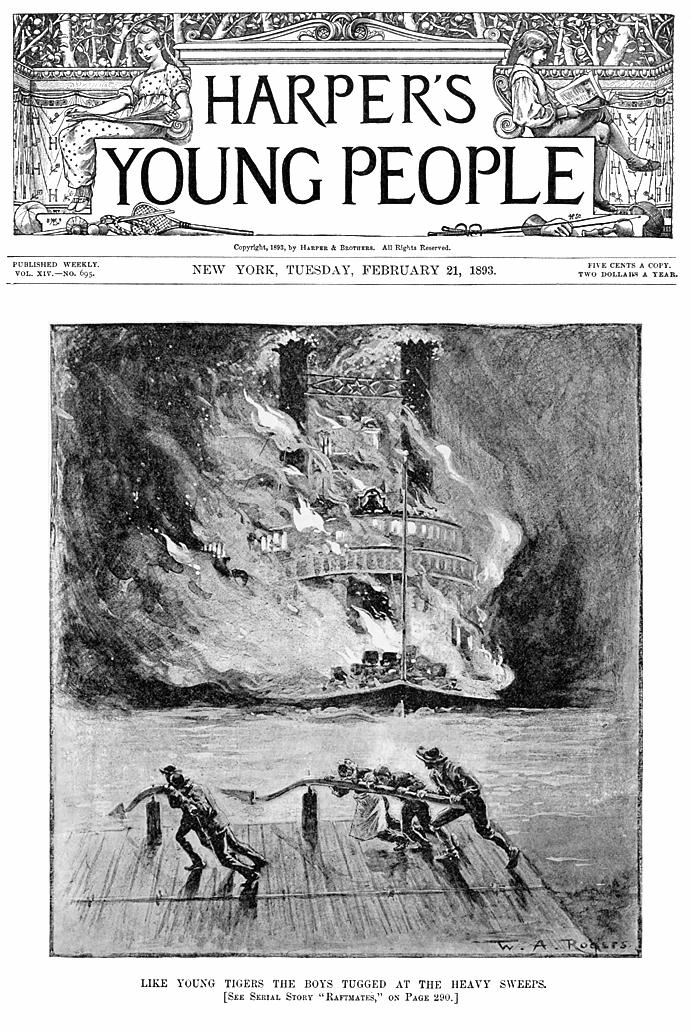
Note the "Purple prose" in caption below the illustration of rafting boys manning the sweeps to get out of the path of a burning steamboat.
This is the 21 February, 1893 cover of HARPER'S YOUNG PEOPLE magazine containing Chapters 33 & 34 of the adventure serial RAFTMATES by Kirk Munroe. From the bound edition of the complete run of the 1893 issues.
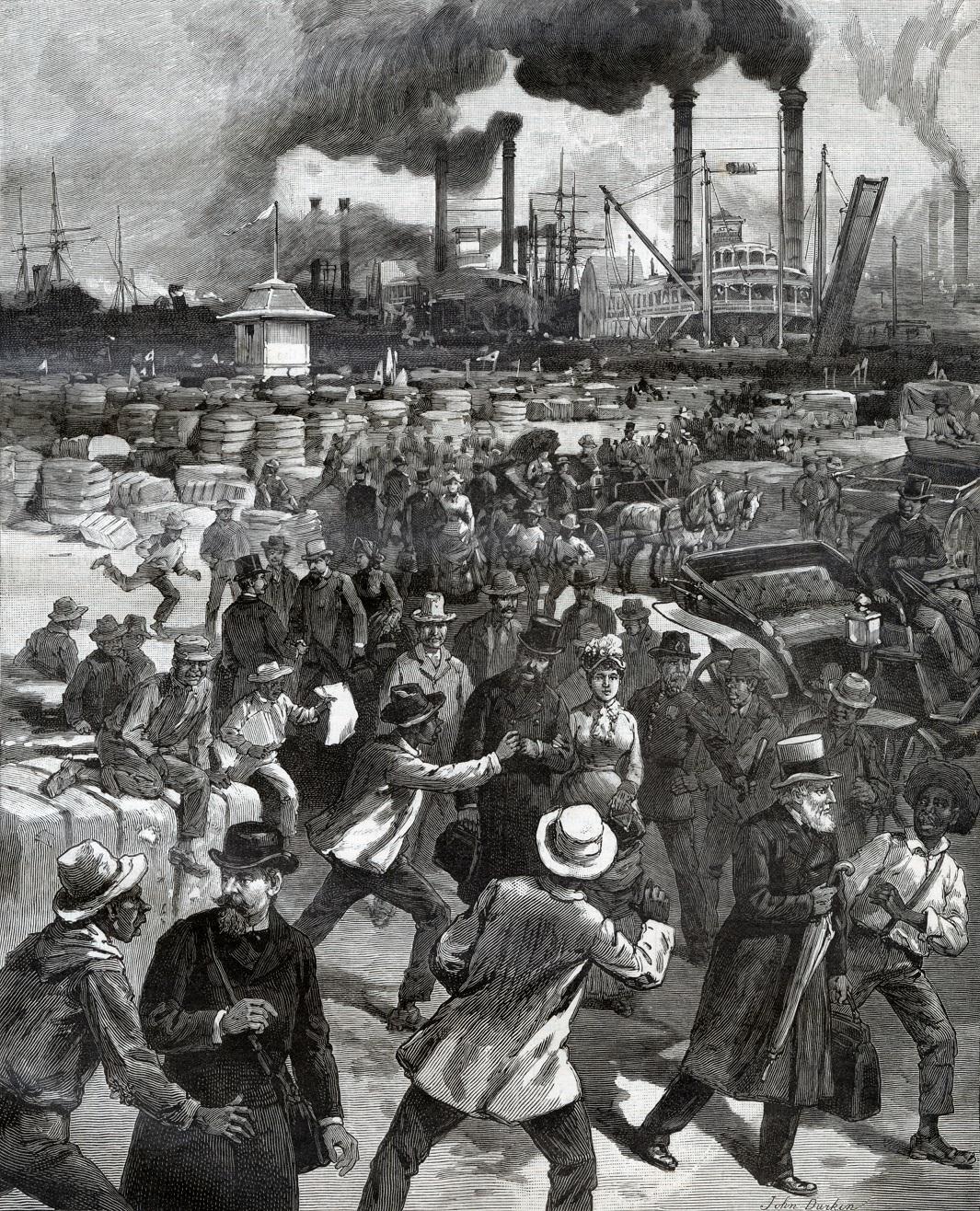
Harper's Weekly January 10, 1885
The New Orleans Exposition - Arrivals at the Levee
This engraving on the front cover represents African American men trying to get new arrivals (who have just disembarked from steamboats in the distance), to hire them to their carry their luggage to wherever they are staying in New Orleans while they are visiting the World's Industrial amp; Cotton Exposition in what is now Audubon Park.
"The New Orleans Exposition - Arrivals at the Levee" - Drawn by Durkin and Graham
nola.com
"The World's Industrial and Cotton Centennial Exposition was conceived to promote New Orleans and mark the 100th anniversary of the nation's cotton industry. The city's first world's fair opened in what is now Audubon Park on Dec. 16, 1884.
The city was "decorated as she never was before" on Dec. 16, 1884, opening day at the exposition, the newspaper noted. The Cotton Centennial Exposition's largest building was also the largest building in the country in 1884. It covered 33 acres and was constructed in about six months.
The Horticultural Hall, the largest greenhouse in the world, was among many notable buildings constructed for the World's Industrial and Cotton Centennial Exposition. It was the only one to remain in use on the site after the fair, but it was destroyed in a 1915 hurricane."
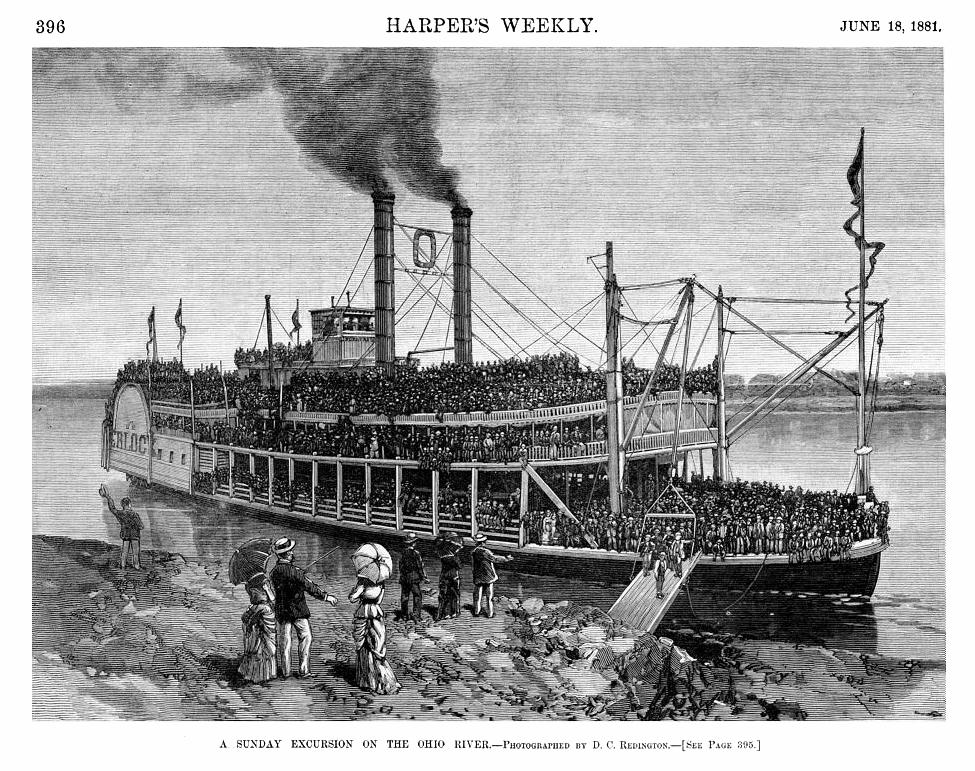
Excursion Steamer THOMAS SHERLOCK on the Ohio River
Engraving of steamer THOMAS SHERLOCK from a photograph by D.C. Redington on Page 396 and accompanying article on Page 395 from the JUNE 18th, 1881 issue of HARPER'S WEEKLY.
CHEAP EXCURSIONS ON THE OHIO.
Cheap excursions are a feature of the summer months on the Ohio River, and nearly all classes participate in them, but not all to the same extent. The laboring people of the larger cities, and especially of Cincinnati and Louisville, take advantage of Sunday and other holidays to get out of town with their families, and at the same time enjoy a ride on the river. They have many discomforts ; but no matter' how much crowded the boat may be on one Sunday, the same class—principally of Germans—is ready for another excursion the following Sunday.
In the summer the steamers used for cheap excursions are those which have ceased to run in their regular trades because of low water. The THOMAS SHERLOCK is the largest steamer engaged in the Cincinnati and New Orleans trade. She is 285 feet long, with a carrying capacity of 1700 tons. The excursion illustrated was extensively advertised, and the steamer chartered to make a trip to Maysville, sixty miles, and return, for $300. The fare for the round trip had been fixed at fifty cents, and the number on board was variously estimated at from 1500 to 3000, the latter figure including children. No liquors were sold, but refreshments could be purchased on the boat. She left the wharf in the morning, and returned after midnight.
A recent event leads to the inquiry, Is there extraordinary danger attached to these monster excursions. There are two, viz., the boilers of a suitable steamboat are two, three, four, or more in number, ranged horizontally side by side, lengthwise of the boat, on the lower deck, immediately over the furnace, and are communicating. Should a passing steamer, or any object on either shore, induce the people to congregate on one side of the boat, she would be so listed that a portion of the water from some of the boilers would find its level in the others. The other danger is from capsizing under certain circumstances. But while these two dangers are mentioned as imminent, the writer can not recall to memory a serious accident that has occurred from either of the causes named.
Special excursion permits are issued to steamers by United States local inspectors, but these have heretofore been in some cases so far disregarded that the number of passengers carried has exceeded the number permitted; but a recent rule from the Treasury Department requires daily reports from the inspectors, which will cause them to guard against a violation of those special permits.
Small towns along the river discourage the advent of large Sunday excursions from the cities, because of the disorder that is likely to prevail; but large excursion parties are organized in these same towns to visit the cities on Sunday. Passengers are added at different points for a distance of one hundred miles or more along the route of the boat, the fare being graded according to distance.
In 1870, the first Saengerfest held in Cincinnati was concluded by a monster picnic, given at a grove on the bank of the Ohio within a few miles of the city, and it was estimated that 50,000 people were transported thither on not more than ten steamboats, each of which made two or three trips. As most of these people remained at the grove till a late hour of the afternoon, the reader may imagine the density of the throng on the last return trip of the boats.
Up to the time when the inclined planes leading to the hill-tops were constructed, short excursions by river to small towns and to picnic grounds were of daily occurrence during the summer, and on Sunday it was not uncommon that six or eight steamers would leave the Cincinnati wharf early in the morning, all decks covered with people, and with bands of music on board, to spend the day outside the city. Two causes operated toward a partial discontinuance of these excursions, viz., owners of boats began to regard Sunday excursions as disorderly; and second, the construction of inclined planes to the hill-tops provided quick transit and pure air at less cost.
Steamers engaged in regular trade sometimes organize special excursion parties for a round trip, always including in the rates of passage both meals and berth, and these rates are usually thirty to fifty per cent. less than the usual fare. Other steamers establish fixed round-trip rates. The rate from Cincinnati to New Orleans and return, occupying about twenty days, and including meals and room from the time the steamer leaves port until she returns, is forty dollars.
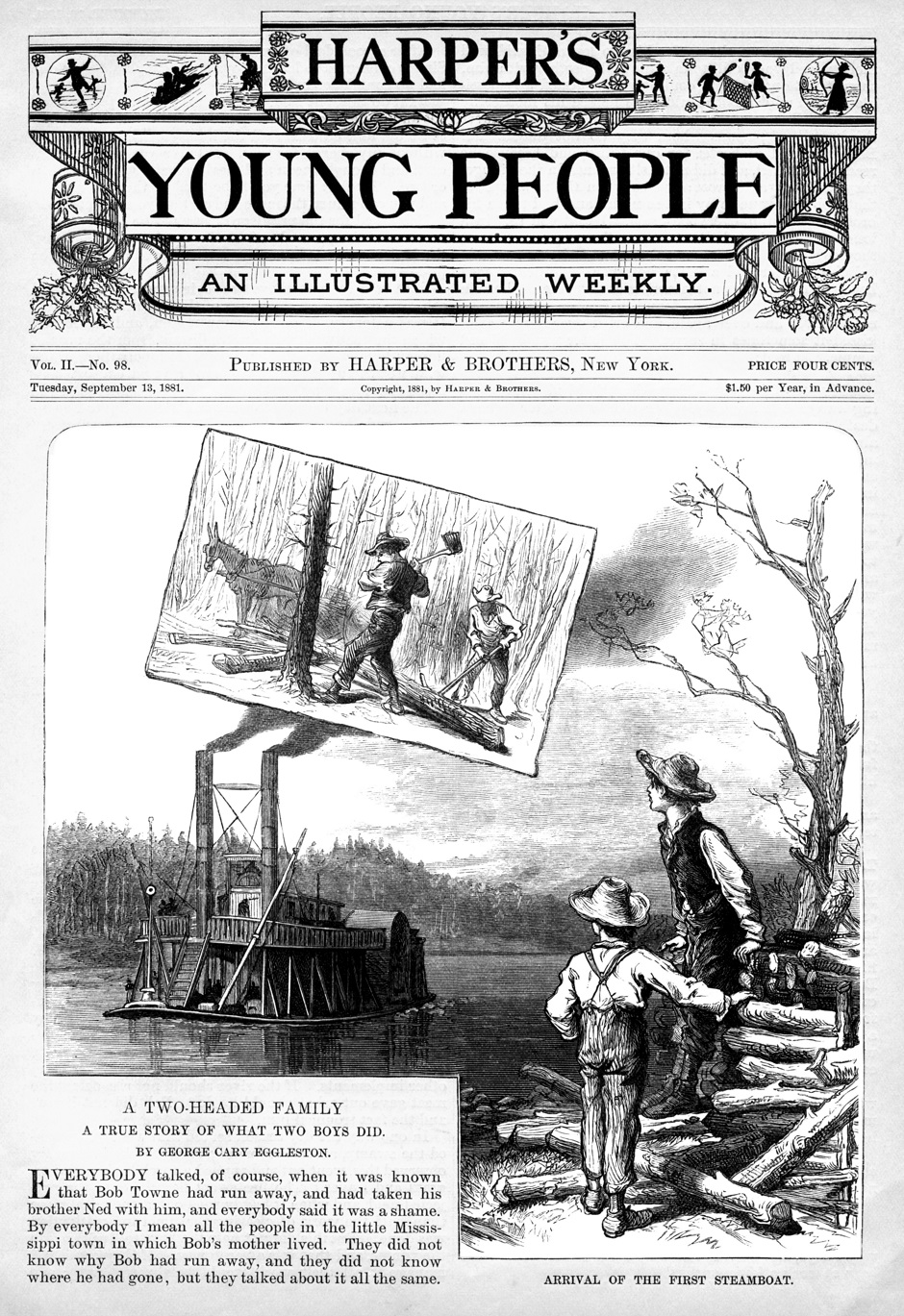
HARPER's YOUNG PEOPLE Vol 2, No. 98 13 September 1881
"A TWO HEADED FAMILY: A TRUE STORY OF WHAT TWO BOY'S DID" by Indiana novelist George Cary Eggleston (1839 - 1911)
The two illustrations on the cover show the young brothers Bob and Ned Towne cutting firewood then watching the approach of a steamboat in need of fuel so the Captain buys their firewood.
Introduction to an extended sample of the story from Pages 722 & 723:
Excerpt from the adventures of Bob and Ned Towne who have run away from their widowed mother's home in Mississippi and ask for a "grub stake" from a land owner who lives 50 miles from their mother's home:
After a good deal of explanation and discussion, Major Singer consented to let the boys try their plan, though he had no confidence in it.
"I'll do this," he said. " You may go into the swamp, cut and sell all the wood you can to steamboats when they come up, and cultivate all the land you choose to grub, without any charge for rent. I'll give you 'a mule and a cart, and enough bacon and meal to last you for a month or two. By that time you'll be tired of the experiment, and you can return the mule and cart on your way home."
Bob asked for the privilege of paying for the mule and cart out of the proceeds of his first crop, and, laughing, the Major consented, naming one hundred dollars as the price.
Five days later the boys ate their supper of bacon and ash-cake on a log on the banks of the Tallahatchee River. It was a lonely, desolate swamp region, and the log on which they sat was twelve miles distant from the nearest human habitation. They were a trifle lonely there in the wild woods, but they had a camp fire and courage, and those go a long way.
The next day they set to work and built a hut to live in, with a rude bunk for a bed. Then Bob "prospected." Much of the land about them had once been cultivated, and there were no trees of any considerable size upon the parts which had been fields; but the growth of cane and brush-wood was appalling.
"Never mind," said Bob. " It is only September now, and we'll get a few acres cleared by spring. Our first work must be to cut a big pile of wood to sell to the steamboats when they come up; if we don't, we can't buy ploughs or food for our farming operations."
"When will the boats come ?" asked Ned.
"Late in the fall or in the winter, when the river gets high enough. It isn't navigable now, but when it rises, the steamboats come up to get loads of cotton."
With brave hearts the boys set to work chopping and hauling cord-wood. They made very little progress the first day, but after they had practiced for a few days they became more expert, and at the end of a week they found by measurement that they could together cut and haul about a cord each day. One grown man would have accomplished more than this; but the boys were satisfied. They had brought a grindstone and some iron wedges with them, and there was no reason to doubt that they could maintain their average of a cord a day. The mule kept in good condition on swamp grass and young cane.
Bob laid out, next the river, the little field which he hoped to get ready for cultivation, and before attacking the timber land he took care to cut into cord-wood all the trees in that little patch which were big enough for the purpose. Then the young pioneers went into the woodlands a little further upstream, and there made rather better progress. The fall was unusually dry. No rain fell, and the river got steadily lower. Meantime the wood-pile had grown by the last of November to more than sixty cords—enough to pay the boys well for their work whenever the steamboats should come. But when could they come? This question was giving Bob a good deal of uneasiness, because his bacon and meal were running low, and he had spent all the money he had for the axes and other implements. If the river should not rise before the meat gave out, what should he do ? Bob did not know, and the fact troubled him.
In one way the dry season served him well. It parched the swamp, and one morning, Ned, who had shrewdly observed this, went out and applied a torch to the dried-up grass and leaves. The fire swept fiercely over the projected field, and when it had burned out, a good deal more than half the work of clearing that field for cultivation was done. But this did not help the boys to live through the winter, and that was a perplexity. If they could not manage it, all their work would be thrown away Bob passed many anxious hours thinking and planning, but with no other result than to make him sleepless.
Still it did not rain, but one morning Ned came in from observing his water-marks, and reported that the river had risen about three inches during the night. This puzzled Bob, and he carefully watched the water. At noon it had risen two inches more. During the night it rose fully a foot. Then Bob began to suspect the truth.
"I have it, Ned," he said.
"Well, how is it? Where does the water come from?"
"From the Mississippi River. That river is high from rains in the north, and it has broken through one of the passes into the Tallahatchee. We'll have steamboats here yet."
"Well, I hope they'll come soon," said Ned. "I've fried our last slice of bacon, and we have only a few pounds of meal left."
"We can eat the mule," said Bob, " rather than starve; but we'll wait on short rations and hope."
There had been a great crop of cotton grown on the Tallahatchee that year, and the dry fall had enabled the planters to pick it more thoroughly than usual. Knowing this, the owners of steamboats at Vicksburg were watching the reports of the water in the Yazoo and Tallahatchee as eagerly as Ned and Bob were watching the water itself, each anxious that his boat should be the first to go up the river.
On the 12th of December Ned cooked the last of the meal. The boys went to bed that night out of food. The next morning they had no breakfast, and had begun to think of killing the mule, or making a journey to the nearest plantation, when about noon a boat appeared. She blew her whistle, and stopped her engines.
"What do you ask for your wood?" shouted the Captain.
"Three and a half," answered Bob.
"Give you three and a quarter, and take all you've got," said the Captain.
"Will you throw in a decent dinner?" asked Bob.
"Yes."
And with that the boat made her landing, and the wood, sixty-three cords, was measured. Then the boys went on board to dinner.
There they learned that in consequence of the prolonged dry season all the people along the river had been too busy picking cotton to cut any wood, and hence the boat had been obliged to send her own men ashore twice to chop wood for her engines. Knowing that other boats were coming, the Captain of this one had made haste to buy all of Bob's wood, meaning to take a part of it at once, and the rest on his way down the river. He had driven a sharp bargain, under the circumstances, but Bob was well satisfied when he received $204.75 for the pile. His first care was to buy of the Captain a good supply of provisions; his next to write a letter to his mother, inclosing a fifty-dollar bill, and, without telling her where he was, giving her news of his own and Ned's health, and promising to write again at the next opportunity. This letter the Captain took to post at Vicksburg.
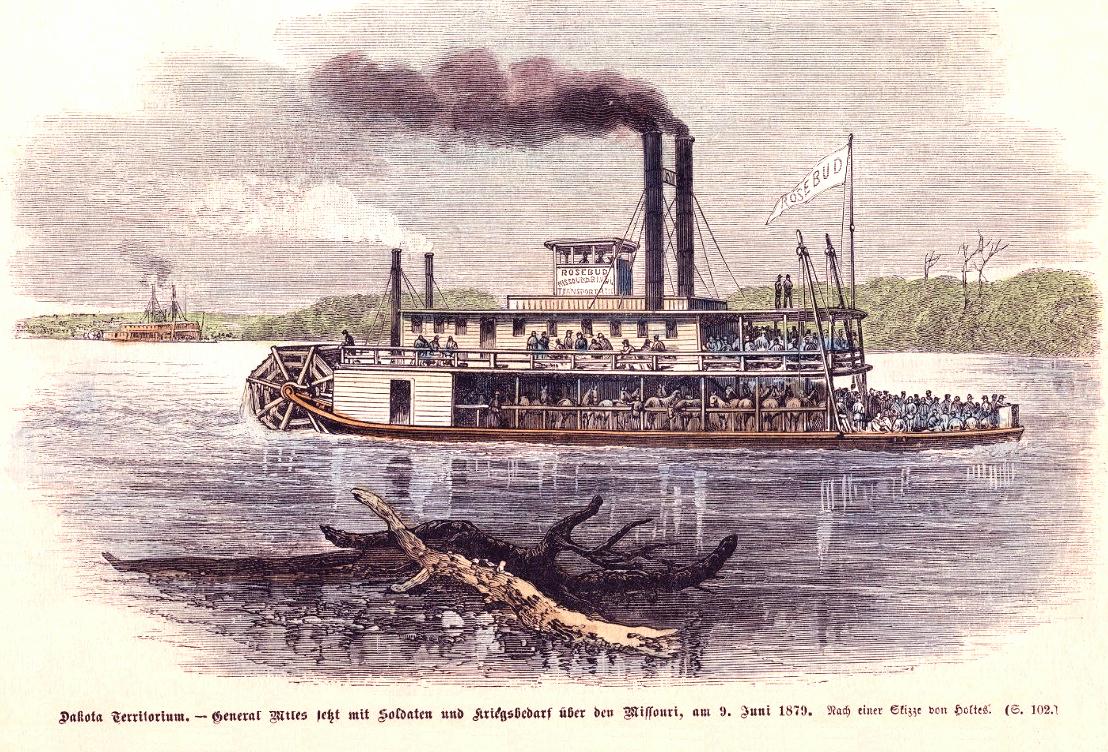
Steamboat ROSEBUD on the Missouri River
Steamboat on river with many men and horses on the two decks.
Signboard on starboard side of Pilot House:
'ROSEBUD Missouri River transportation'
Other steamboat in distance near shore, likely the DAKOTA.
German caption: "Dakota Territorium. -- General Miles setzt mit Soldaten und Kriegsbedarf über den Missouri, am 9. Juni 1879. Nach einer Skizze von Holtes. (S. 102) -
Translation of German text: "Dakota Territory. General Miles moves troops and war supplies across the Missouri on June 9, 1879." Sketch by Holtes. (P. 102)"
The New Campaign Against Sitting Bull:
General Nelson A. Miles was assigned to organize and put in motion a strong column to drive invading Indians back. The famous young Indian fighter proceeded to established his supply depot at Old Fort Peck, using the steamers ROSEBUD and DAKOTA in gathering his men and materials. On the 8th of June, 1879 two companies of the Sixth Infantry arrived at the camp, and a few hours later the DAKOTA appeared with supplies of all kinds for the expedition.
Digital Horizons Life on the Northern Plains - Dakota Lithographs and Engravings - North Dakota State University
digitalhorizonsonline.org
Image in public domain.
Credit Line Institute for Regional Studies, NDSU, Fargo (Folio 102.TrS73.1)
Original Source Lithograph from unknown source, perhaps Leslie's magazine. Item Number Folio 102.TrS73.1. In consequence of the reports that bands of Sioux from Sitting Bull's encampment in Canada had crossed the line, the while ostensibly hunting buffalo were raiding isolated white settlement, orders were issued in the latter part of June to General Nelson A. Miles to organize and put in motion, with all haste, a strong column to drive the Indians back. With his accustomed alacrity the famous young Indian fighter proceeded to execute his orders, and as we write has already had an encounter with the invading hostiles. He established his supply depot at Old Fort Peck, using the steamers Rosebud and Dakota in gathering his men and materials. On the 8th of June two companies of the Sixth Infantry arrived at the camp, and a few hours later the Dakota appeared with supplies of all kinds for the expedition. On the morning of the 9th his scouts reported at the south bank of the Missouri. Throughout that day the boats were engaged in transporting troops, friendly Indians, guns, ammunition, etc., to the north bank. General Miles took his departure from Fort Benton, July 14th, with 800 men. He left a guard at Fort Peck and four companies at Mussel Shell, and started north with the rest. He has with him a battery of six Rodman and Hotchkiss guns, 140 boxes of shell, 22,000 rounds of revolver cartridges, 200,000 rounds of rifle cartridges, twenty-five travois and several ambulances.
The first intelligence from the moving column was in the form of a dispatch from Fort Keogh, which said an engagement took place near the mouth of Beaver creek on the 17th, between two companies of troops and Lieutenant Clark's Indian scouts of General Miles's command, and 300 hostile Sioux. The troops lost four Indian scouts killed, and two soldiers were wounded. When General Miles's main column, which was twelve miles behind, came up, the Indians were pursued fifteen miles, but made their escape to Sitting Bull's camp, which was but a few miles off, and on this side the line. Bear Wolf's band of Crows, who are at Terry's Landing, report 300 lodges of Sioux on this side of the Missouri, on their way to Keogh to make friends with the whites. On July 24th, Secretaries McCrary, Thompson and Schurz had a conference at the War Department with regard to the present Indian outlook in the Northwest. They were unanimously of the opinion that every precaution to prevent hostilities with the Indians should be taken, and as positive orders have been sent to General Miles to proceed cautiously and quietly, and not to bring on a war, no serious conflict is anticipated, although, of course, it cannot be known what action Sitting Bull may take should he perceive the soldiers near the Canadian line. It is thought to be the intention of General Miles to approach the border with a view to reconnoitering Sitting Bull's camp. With reference to the reports from American sources that Sitting Bull's band is on the warpath, the Canadian Department of the Interior does not credit any such rumors.
Recent advices from the northwest say that Sitting Bull and his men are peaceably inclined. Their relations with the mounted police were never more satisfactory. It is believed there that General Miles has been misled by the traders and scouts, who are always anxious for a fight. All is quiet within the Canadian territory."
Article accompanying image, publication unknown.
Notes Title provided by staff.
Artist unknown.
"Dakota Territory. General Miles moves troops and war supplies across the Missouri on June 9, 1879." Sketch by Holtes. (P. 102)" - Translation of German text. Contributor Holtes, Charles Contributor Role Illustrator Repository Institution North Dakota State University Libraries, Institute for Regional Studies Repository Collection Dakota Lithographs and Engravings Collection Folio 102 Collection Finding Aid Consult: hdl.handle.net
Rights Management Image in public domain. Language ger; Digital ID rsL00090
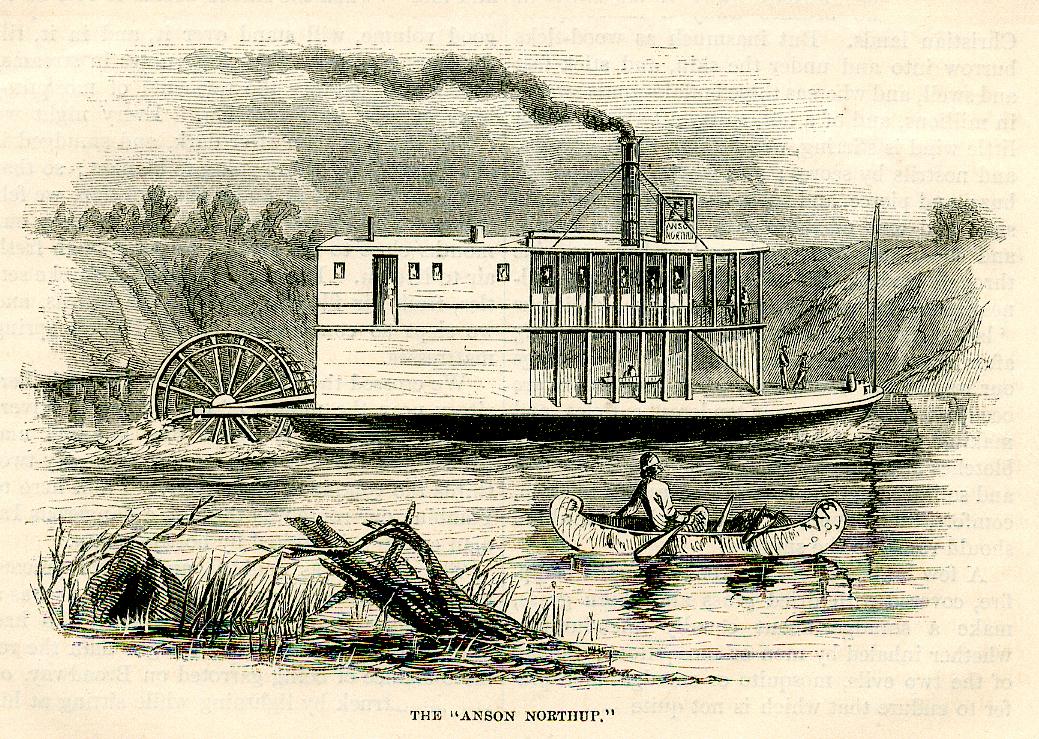
Steamer ANSON NORTHUP on the Red River 1858 '59 '60
HARPER'S NEW MONTHLY MAGAZINE
AUGUST 1860
Page 307
From "TO RED RIVER AND BEYOND"
Late in the winter of 1858-9, Mr. Anson Northup, having run his boat up the Crow Wing River, a tributary of the Mississippi, the previous fall, took it to pieces, packed the cabin, machinery, and timber for building the hull, on sleighs, which, with great difficulty, were drawn by horses and oxen across to Otter Tail Lake, and thence westward to the mouth of the Cheyenne on the Red River. Assisted by the St. Paul Chamber of Commerce, but mainly depending on his own private resources, and by hard work and perseverance, the boat was rebuilt on the banks of Red River, and launched successfully on the 19th of May, and, as the breaking bottle drenched the planks, was christened the ANSON NORTHUP. In the high- water of early spring she made her trial-trip down to Port Garry and back. She had to lie by every night, of course, and must have been greatly delayed by the necessity of stopping to cut timber for the fire. In spite of these delays, she made the return trip in eight days; and what must the quiet Selkirkers have thought of the American steamboat? The Albany burgomasters were not more amazed by the sound of the CHANCELLOR LIVINGSTON's paddles.
And now about the navigation of Red River. Such navigation is undoubtedly feasible. The boat's two trips to Port Garry have demonstrated it. In the latter part of the fall, and. in the winter of course, it is impracticable. After the ice breaks up, which usually happens about the 1st of May, the water is very high, and the river is navigable to as large steamboats as can make all the turns in the winding river, from Fort Abercrombie to the mouth at Lake Winnipeg—nearly five hundred miles. After the 1st of August the water has fallen sufficiently to reveal serious obstructions in the channel from the fort to the mouth of the Cheyenne River, its largest tributary but one, entering Red River fifty or sixty miles below the fort. But from this point to its mouth it is easily navigable in the lowest stages of water, until the ice forms in early November. The success of the boat works a revolution in the Company's business. Hereafter the annual outfit and returns will pass through the United States, instead of by the difficult and circuitous passage of Hudson's Bay, to York and Moose Factories.
The train did not cross the river above the fort as we did, but continued on for about fifty miles down the east side of the river to the Cheyenne Crossing, near the mouth of the Cheyenne River. Joseph and I, who had remained behind, crossed the river on the ANSON NORTHUP, swimming our horses. We therefore had to ride thirty-four miles on the trail of the train, doing their two days' travel in one day, and that the hottest of the season. The air was really furnace-like, reminding one of the accounts from India of the scorching heats of mid-day in that more tropical climate.
But when we got to camp, two hours after sunset, there was still no rest for us. Mosquitoes abounded, biting our hands, and necks, and faces, as we cooked our suppers, and flying into our eyes and mouths whenever we dared to open either. At this season of the year mosquitoes are the intolerable curse of travelers, the little black fly the tolerable curse, and wood-ticks the curse. As for the rest of the entomological creation, they bear no comparison with these in their power of inflicting annoyance and petty misery upon the human race; and one soon gets the habit, I found, of brushing a spider from his face, an ant from his neck, or taking any creeping, crawling thing from the inside of his nearest piece of clothing with the same indifference with which he brushed away a house fly in Christian lands.
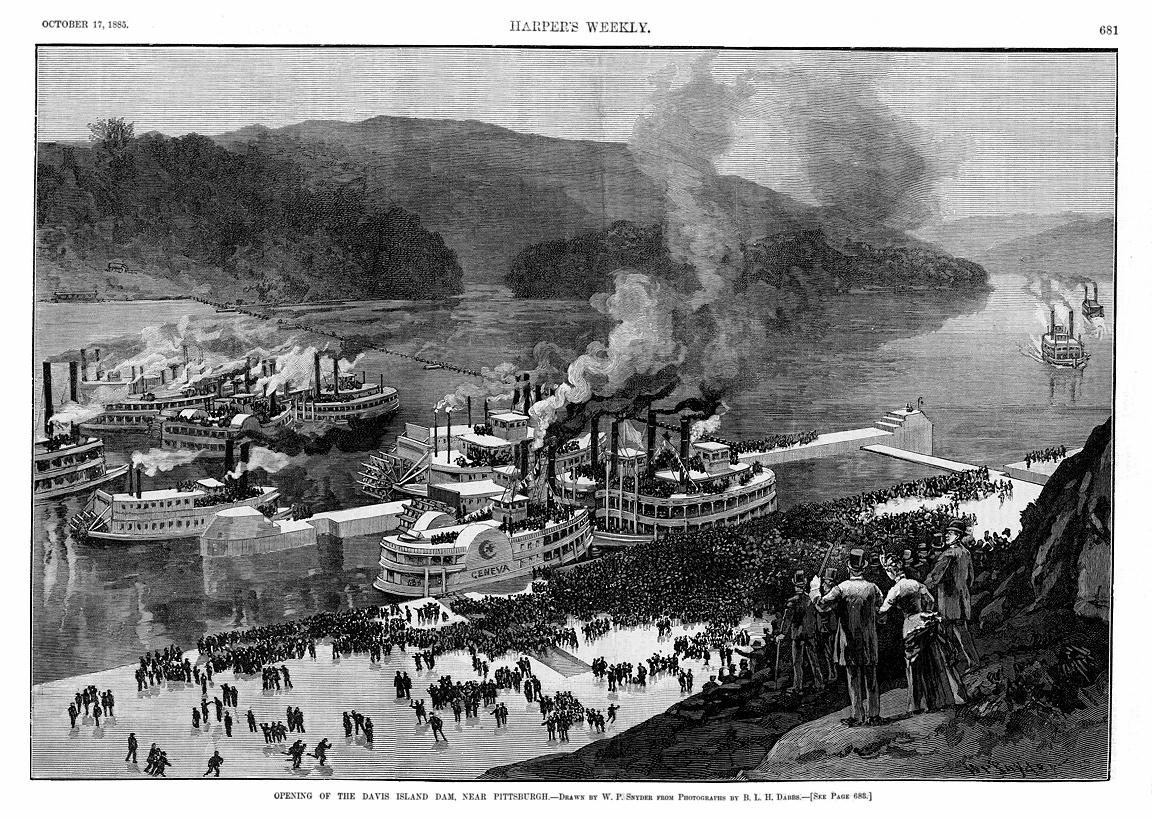
OPENING OF THE DAVIS ISLAND DAM, NEAR PITTSBURGH
Harper's Weely page 681 October 17th, 1885
OPENING OF THE DAVIS ISLAND DAM, NEAR PITTSBURGH
Drawn by W.P. Snyder from Photographs by B.L.H. Dabbs
loc.gov
Davis Island Dam & Lock No. 1, Ohio River, mile 4.7 on right bank, Pittsburgh, Allegheny County, Pennsylvania Building/structure dates: 1878-1885 Initial Construction As the first lock and dam on the Ohio River, the Davis Island Lock and Dam was an experimental project testing the skills of the 19th century engineers. Project design achievements included the first rolling lock gates, the largest movable dam built in the 19th century, and the widest chamber of world history. Project construction engineering gained increased efficiency through conversion from manpower to steampower. Especially notable was the study of national and international engineering technology performed during planning and construction phases. The civil engineers associated with the project included several of the founders of the Engineers' Society of Western Pennsylvania; military engineers supervising the project included Frederick A. Mahan, international waterways engineering expert; William E. Merrill, the "Father of the Ohio River Project"; George W. Goethals of Panama Canal fame; and William M. Black and Lansing H. Beach, who later served as Chief of Engineers, US Army.
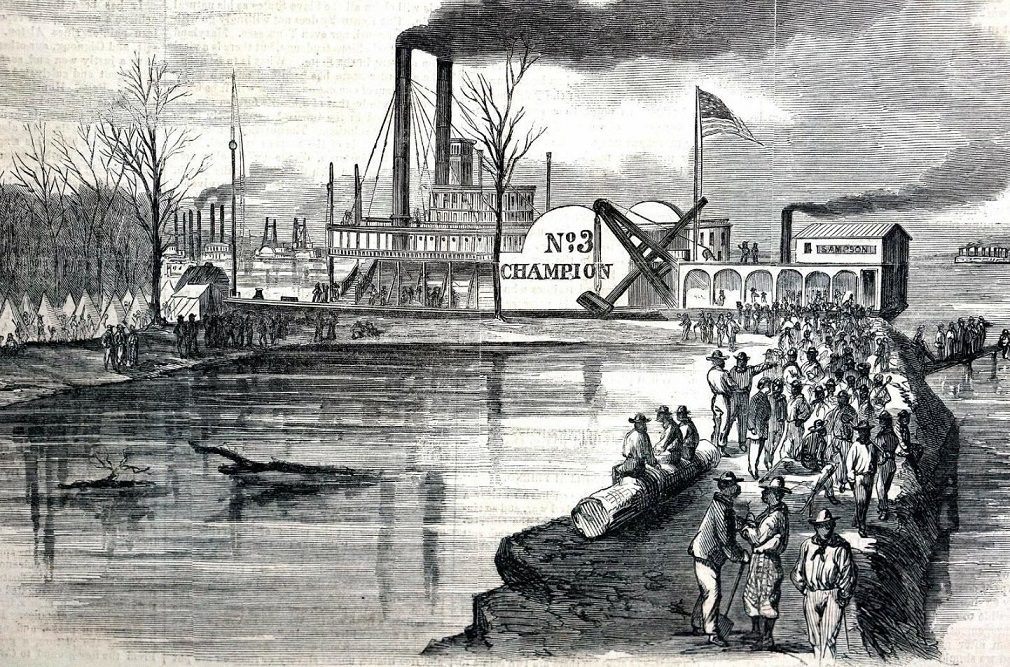
Harper's Weekly 3 May 1862 engraved illustration
Steamers sunk by Rebels between Island Number 10 and New Madrid, Missouri
Harpers
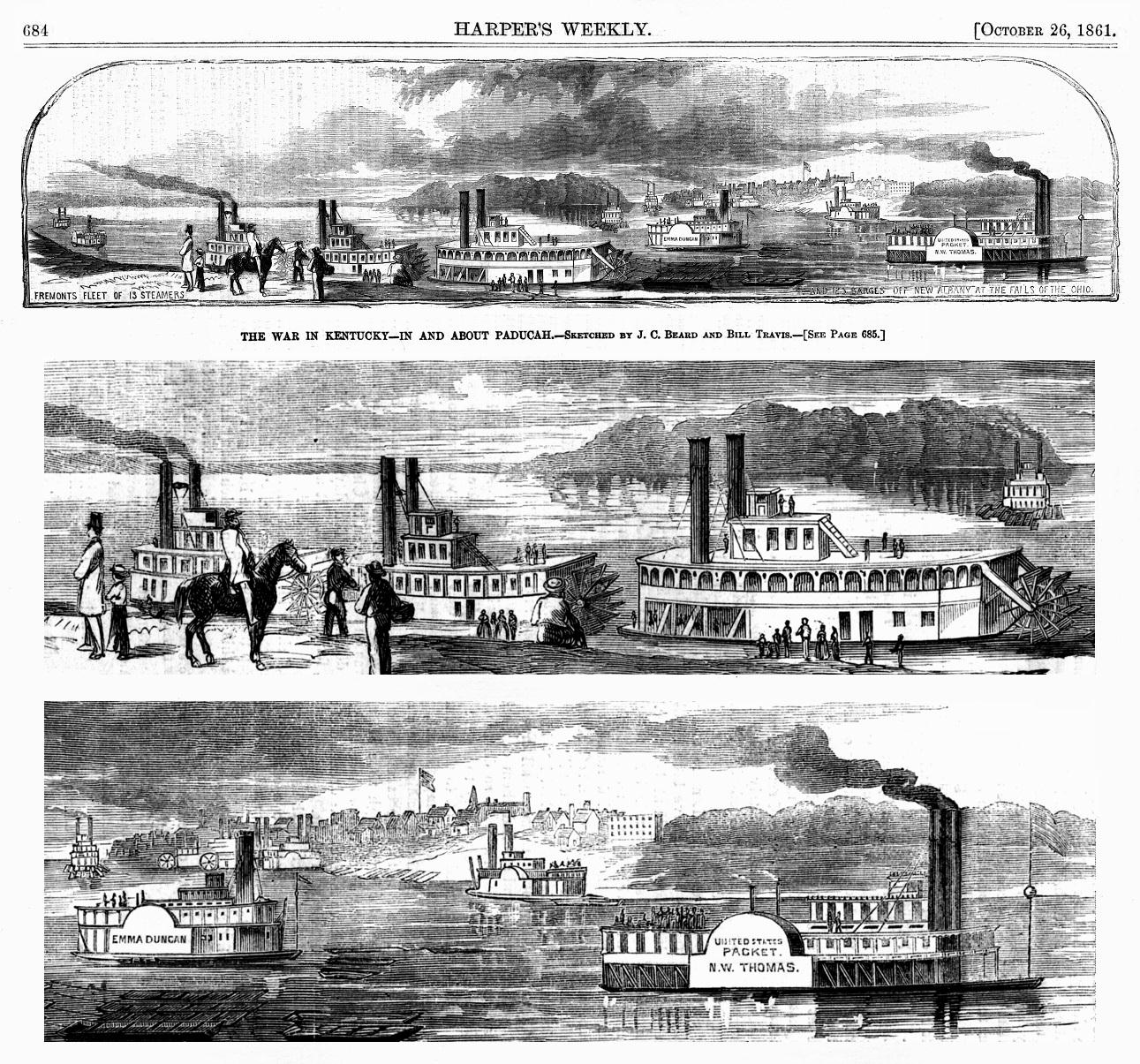
Harper's Weekly Oct 1861 steamers EMMA DUNCAN and N.W. THOMAS
Harper's Weekly October 26, 1861 page 684 sketches by J.C. Beard and Bill Travis were the basis for a page full of engravings captioned THE WAR IN KENTUCKY - IN & ABOUT PADUCAH. This attachment above is from page 684 of the top panel with larger details from the left and right halves of the top panel included below that in this composite for a closer look at the boats.
Represented on the far right were the EMMA DUNCAN and the N.W. THOMAS. In the lower left and lower is inscribed FREMONT's FLEET of 13 STEAMERS AND 125 BARGES OFF NEW ALBANY (Indiana) AT THE FALLS OF THE OHIO. The sidewheeler EMMA DUNCAN was built in 1860 at Pittsburgh, named for the daughter of a Cincinnati furniture manufacturer and constructed on a wooden hull measuring 180 feet in length by 34 feet in width, for the total cost of $27,000.
Three boilers supplied steam to engines having 24-inch cylinders with a 6-foot stroke. The sidewheels were 28 feet in diameter with bucket planks 8 feet in length.
The boat was owned by Capt. F.Y. Batchelor, who initially operated it in the Cincinnati-St. Louis trade, later changing to the Cincinnati-Pittsburgh run.
The DUNCAN transported supplies for the U.S. Army during the Civil War, under the command of Capt. Stanton Batchelor.
The vessel was reportedly under charter to the government in the fall of 1862, when it was ordered to go to Louisville and referred to in official correspondence as a gunboat.
On March 24, 1863, Rear Adm. David D. Porter, of the U.S. Navy, purchased the steamboat at Cairo, Ill., for $39,000.
The boat's name was changed to the U.S.S. HASTINGS and under that name it was ultimately abandoned in 1872.
The sidewheeler N.W. THOMAS was built at Cincinnati, Ohio in 1853—Length 190 feet—Breadth 49 feet—419 Tons
At the beginning of the Civil War in 1861 the N.W. THOMAS was conscripted by the Federal government and assigned to the U.S. Quartermasters Dep't.
"The immensity of steamboat concentration was revealed to the people of Evansville, Indian when on September 18, 1861, a fleet of thirteen steamers, with the steamer N.W. THOMAS as flagship, and 120 barges, came down to Evansville where they laid over to receive further instructions before proceeding to Cairo. A large crowd was on hand at the wharf to greet the fleet."
excerpted from "Evansville Steamboats During the Civil War" by Milford M. Miller
Indiana Magazine of History, 1941
Volume 37, Issue 4
pages 359-381
The entire article can be found here: scholarworks.iu.edu
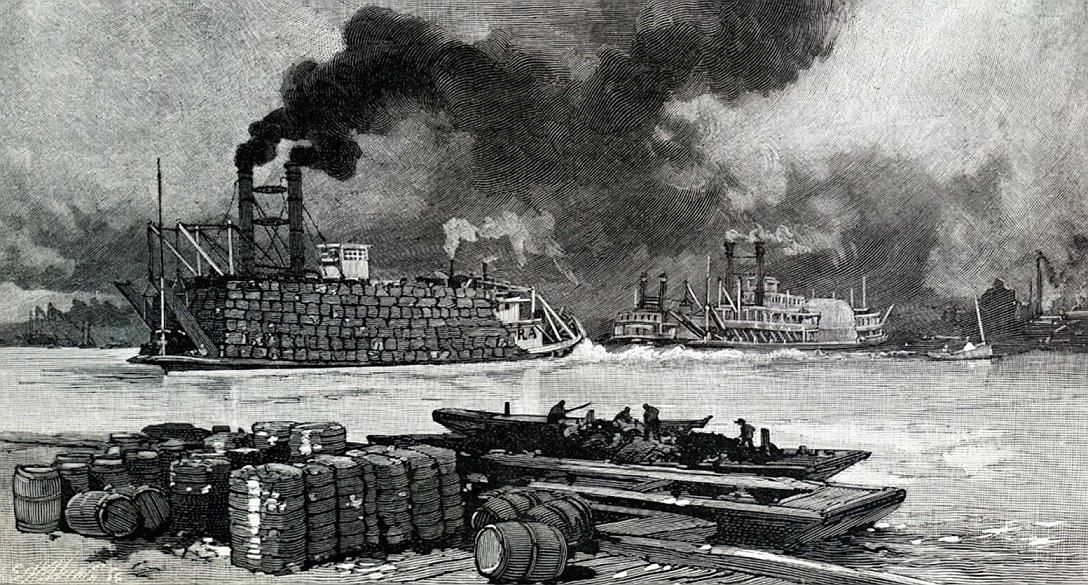
cover Harper's Weekly May 7th 1887 illustrating "THE NEW SOUTH"
Detail from lower portion of cover Harper's Weekly May 7th 1887 illustrating "THE NEW SOUTH" Engraving of 3 steamboats in the distance and wharf with barrels and cotton bales in the foreground.
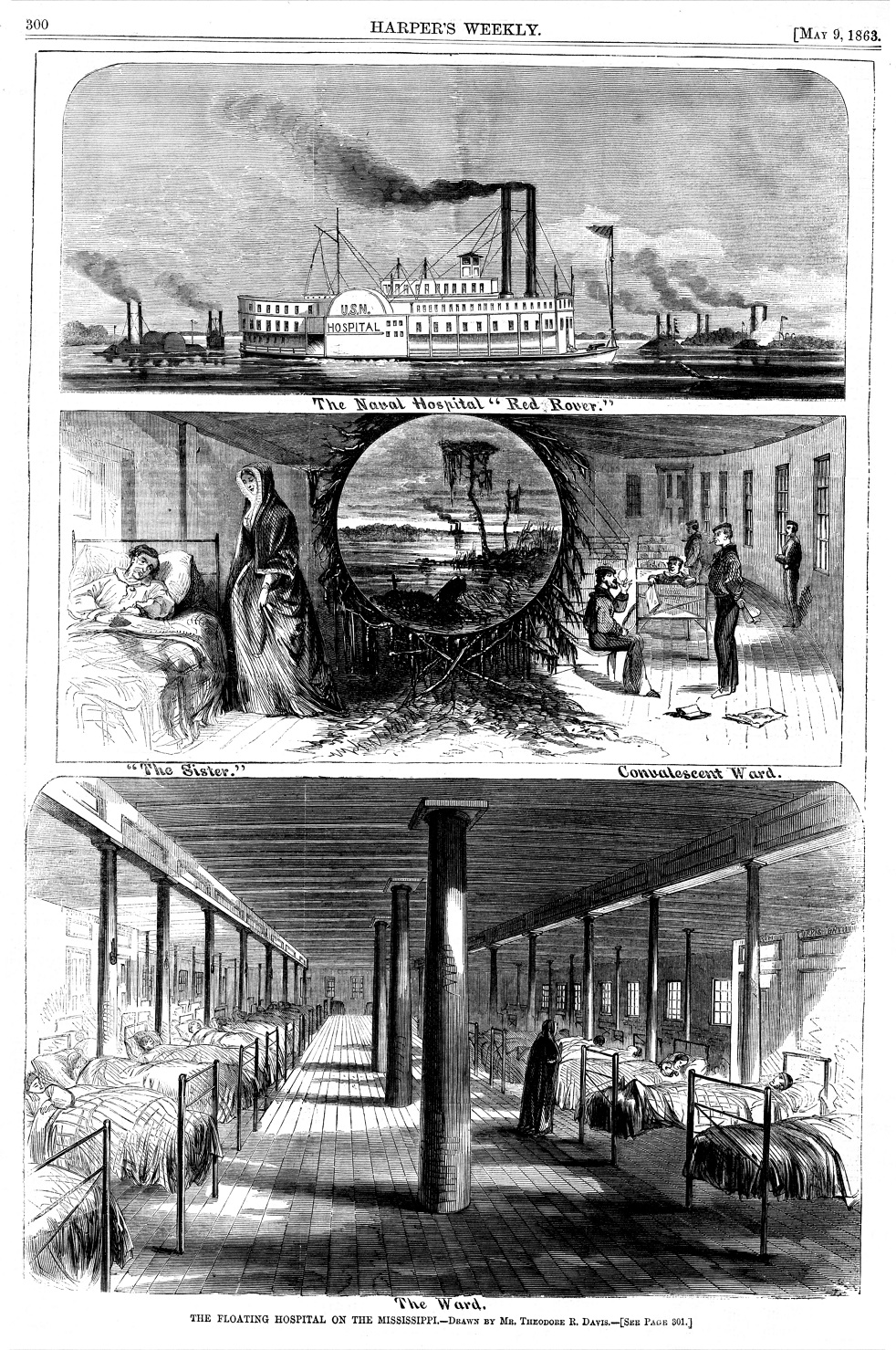
Civil War Harper's Weekly - Union Navy Hospital Steamboat RED ROVER
May 9, 1863. HARPER'S WEEKLY.
Text on page 299
THE NAVAL HOSPITAL BOAT
"RED ROVER."
"This institution, which we illustrate on page 300, is under the charge of Surgeon George H. Bixby and Dr. Hopkins, and is an untold comfort to our sick or wounded sailors. The sketch shows the main ward, in which are accommodations for over two hundred patients. The Sister is one of those good women whose angelic services have been sung by poets and breathed by grateful convalescents all the world over. The convalescents are placed in a ward for their sole use, where they smoke, read, and generally enjoy themselves. The boat itself, a clean, roomy craft, is under the command of a gallant old sailor."
WATERWAYS JOURNAL
OLD BOAT COLUMN
The Hospital Boat Red Rover
By Keith Norrington
MARCH 17, 2019
Built at Louisville, Ky., in 1857, the large sidewheeler Red Rover ran in the Nashville - New Orleans packet trade.
Constructed on a wooden hull that measured 256 feet in length by 40.9 feet in width and with a depth of 7.6 feet, the vessel was powered by engines having 28-inch cylinders with an 8-foot stroke; five boilers supplied the steam.
Known as "Fife Major's boat," it was teamed up with the packets James Johnson and James Woods in 1860, with Capt. William Strong in command.
The vessel was purchased by the Confederacy on November 7, 1861 for $30,000 and pressed into transport service at Columbus, Ky., and at Island No. 10. While at the latter location, the steamboat was struck by a shell, which disabled it. Tied up, the Red Rover was captured, along with three other boats lying along the Tennessee shore, by Union troops. Engineers from the gunboat Mound City restored the Red Rover to operating condition and it was promptly dispatched to Cairo, Ill. Shortly thereafter, the vessel was taken to St. Louis, where it was converted into a hospital. The conversion included the installation of bathrooms, a laundry, two kitchens, a 300-ton ice box, gauze blinds on the windows, an operating room, an elevator from the main to boiler deck, a medical dispensary, bedding, furniture and sanitary stores. The Red Rover's first mission of mercy was to the aid of the Mound City, which was hit by a shell to a boiler at St. Charles, Ark., resulting in many deaths and injuries. The wounded soldiers were taken to Memphis. Sister Angela, Mother Superior of the Sisters of the Holy Cross at Memphis, volunteered the services of her order aboard the riverboat; this act of kindness was the forerunner of the United States Navy Nurse Corps.
Once the wounded were removed to the hospital, the Red Rover was hauled out on the Mound City marine ways for much-needed hull work, after which the boat was sent to Vicksburg.
Later, at Helena, Ark., the boat caught fire but did not sustain serious damage. Repairs were made at Mound City, at which time the decks were enclosed to permit winter service. Early in 1863, the vessel was sent to Vicksburg and offered support during the siege; the boat was utilized in the area, making a trip to Memphis with wounded.
During the spring of 1864, the Red Rover was sent to New Orleans, distributing medical supplies along the way. Later that summer, the mission was repeated, to Donaldsonville, and again to New Orleans.
Early in 1865, the Red Rover departed Memphis for Mound City, where the steamboat spent its remaining active duty as a United States hospital ship. Sold at public auction on November 29, 1865, the veteran vessel was purchased by A.M. Carpenter for $4,500. Never to run again, the heroic steamboat was ultimately scrapped.
Other United States hospital boats that operated on the Western Rivers during the Civil War were the Empress, D.A. January, City of Louisiana and the Imperial. All were equipped by the Western Sanitary Commission.

With the exception of images credited to public institutions,
everything on this page is from a private collection.
Please contact Steamboats.com for permission for commercial use.*
All captions provided by Dave Thomson, Steamboats.com primary contributor and historian.
